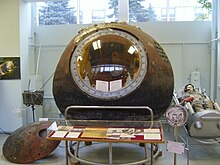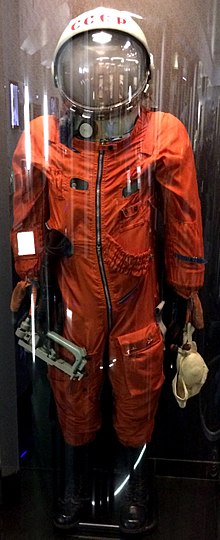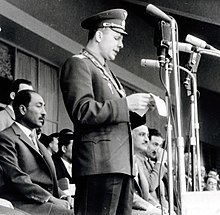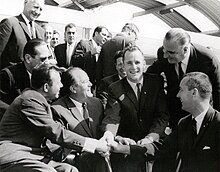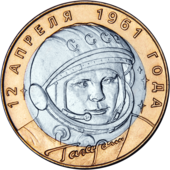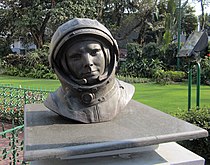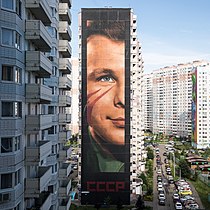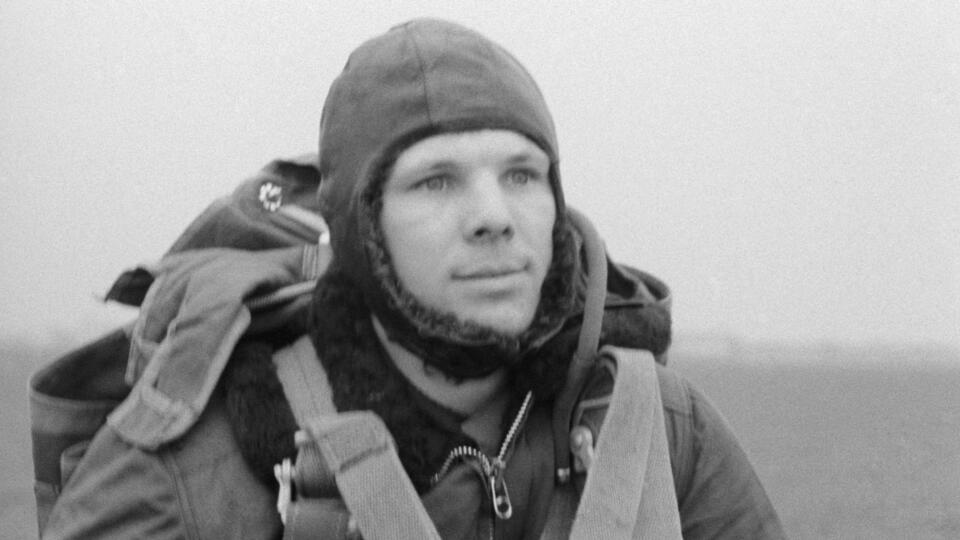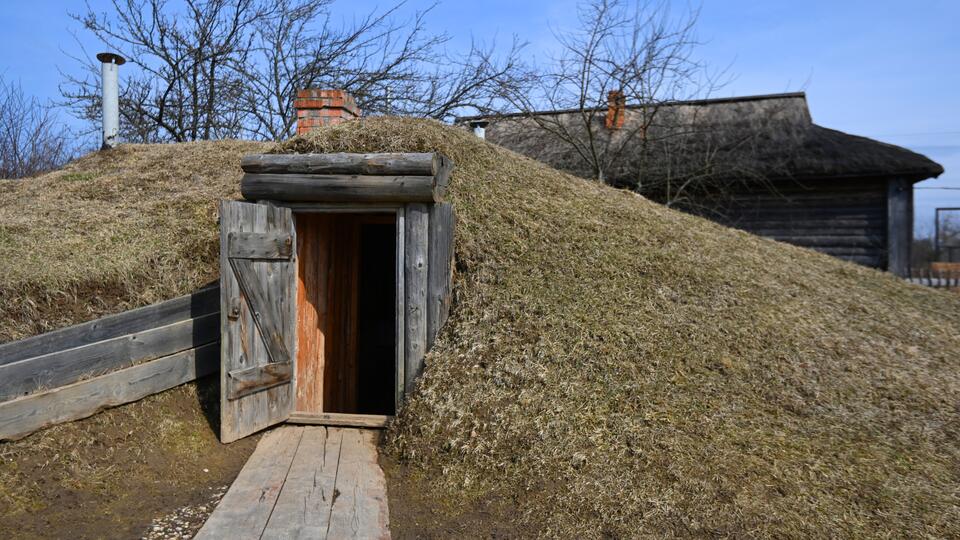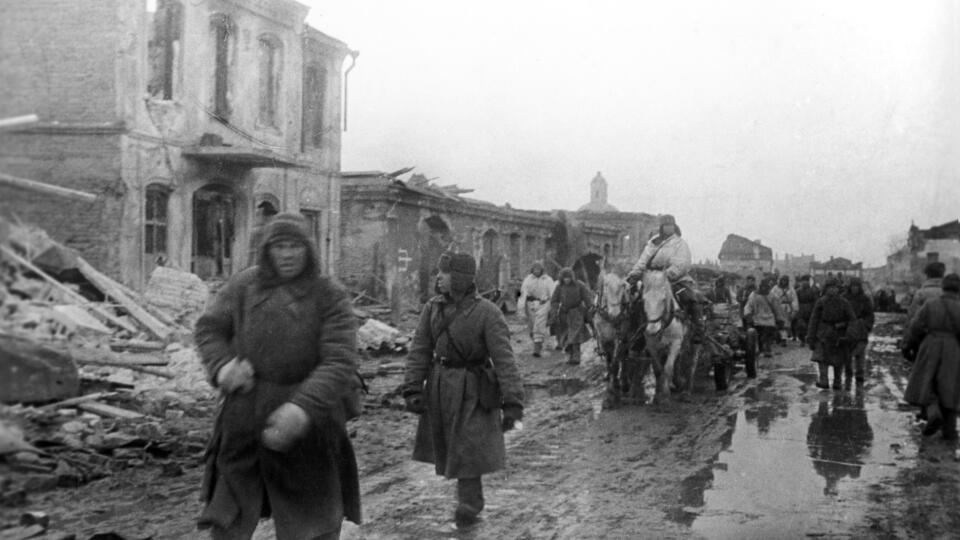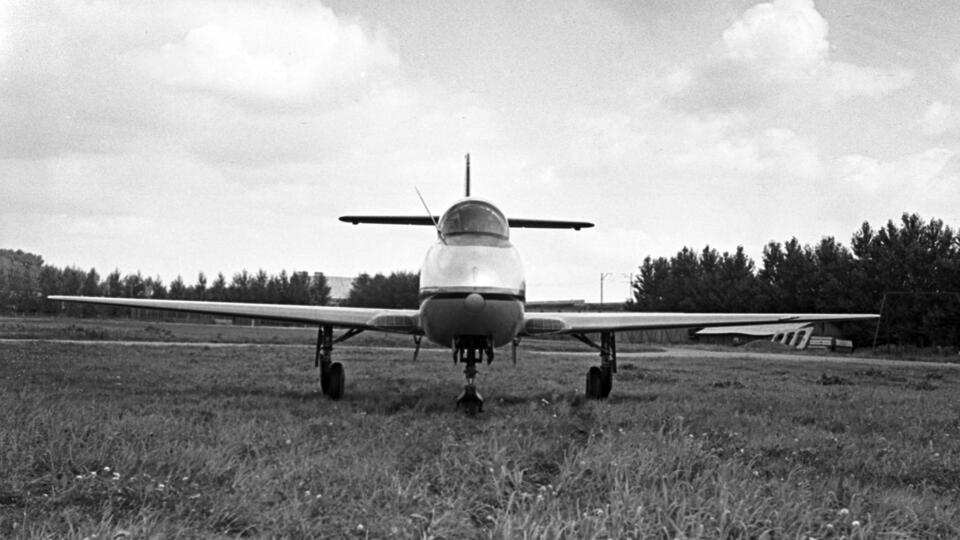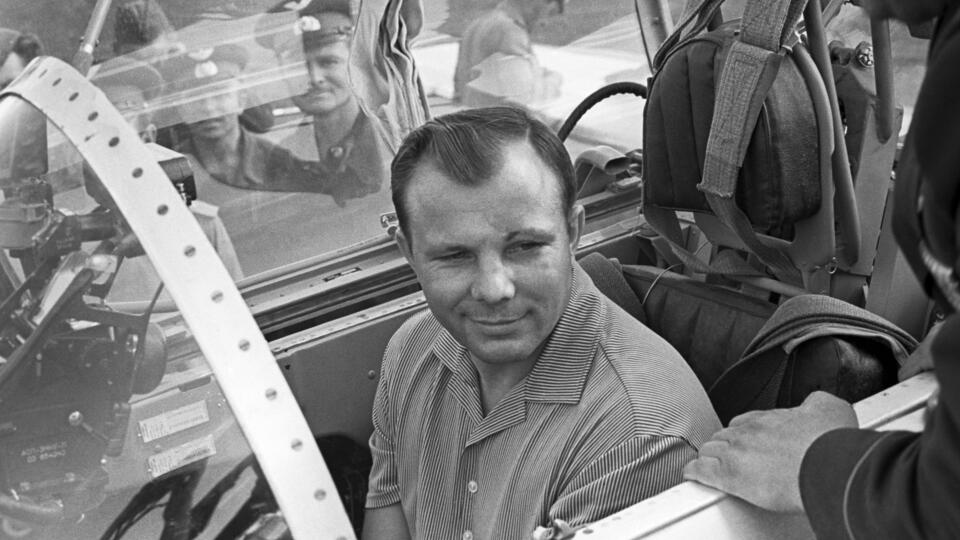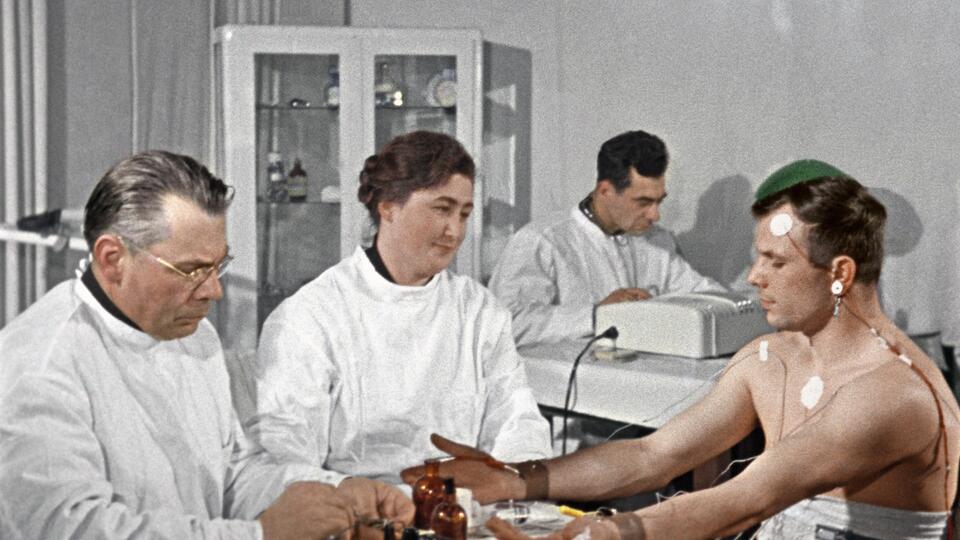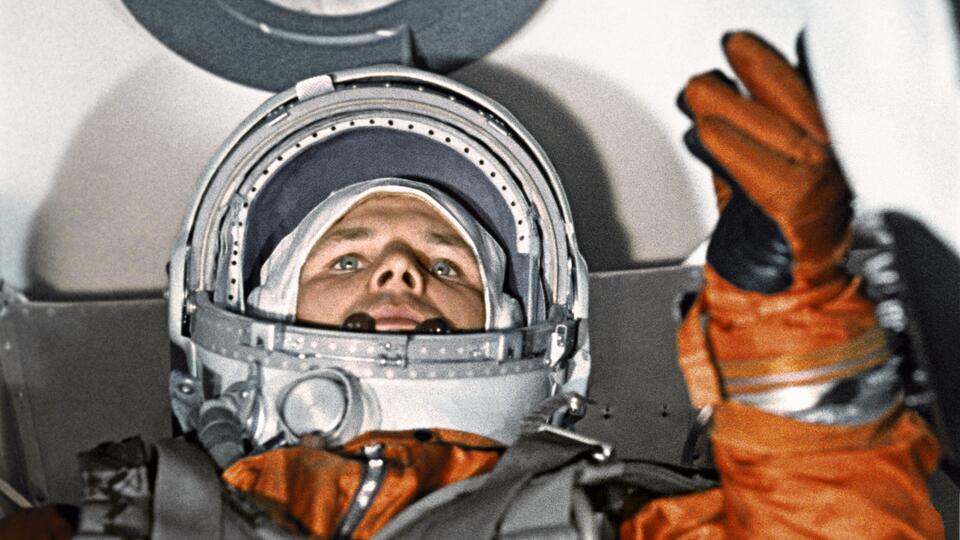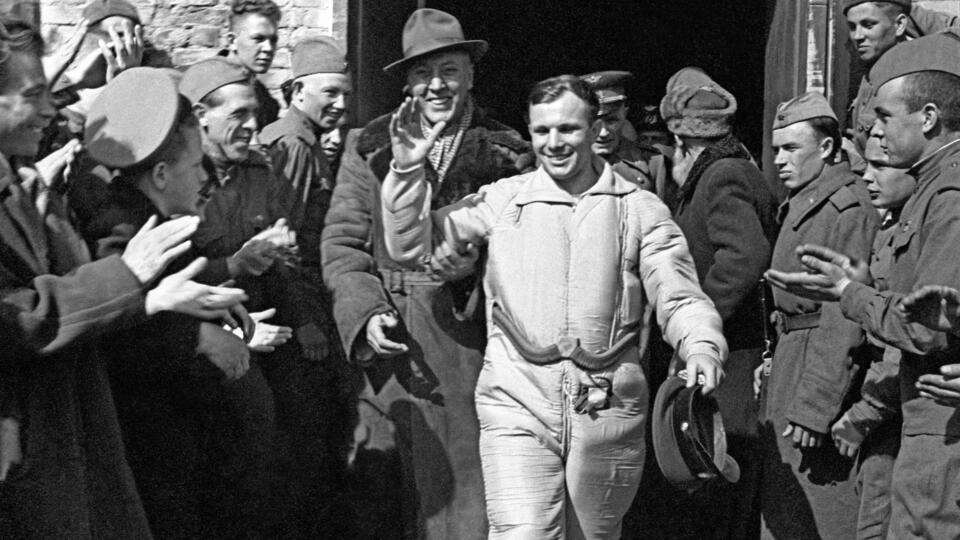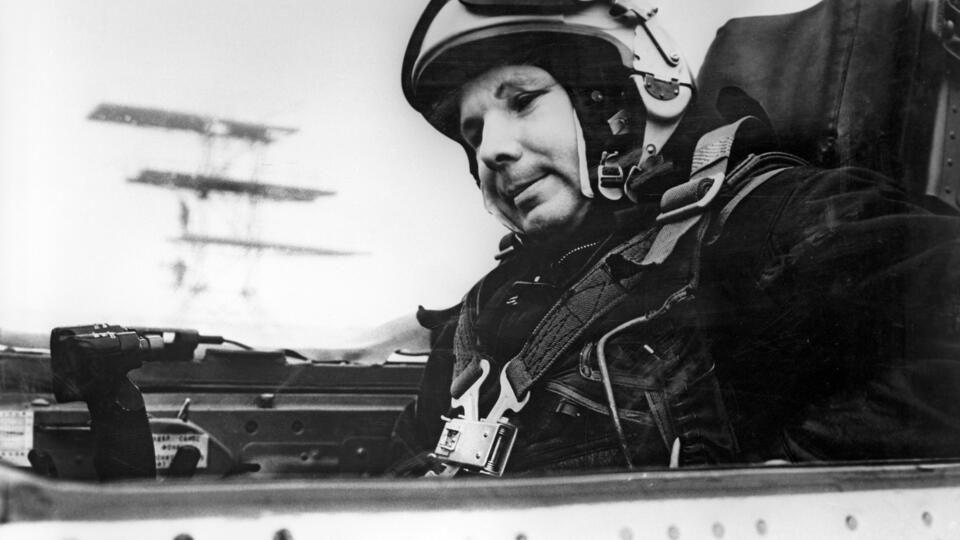|
Yuri Gagarin |
|
|---|---|
|
Юрий Гагарин |
|
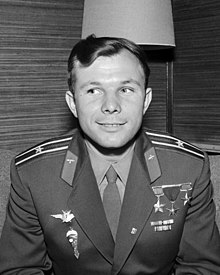
Gagarin in 1961 |
|
| Born |
Yuri Alekseyevich Gagarin 9 March 1934 Klushino, Russian SFSR, Soviet Union |
| Died | 27 March 1968 (aged 34)
Novosyolovo, Russian SFSR, Soviet Union |
| Cause of death | MiG-15 jet crash |
| Resting place | Kremlin Wall Necropolis, Moscow, Russia |
| Occupations |
|
| Spouse |
Valentina Goryacheva (m. 1957) |
| Awards |
|
| Space career | |
| M.O.M. cosmonaut | |
|
Time in space |
1 hour, 48 minutes |
| Selection | Air Forces Group 1 (1960) |
| Missions | Vostok 1 |
| Military career | |
| Allegiance | Soviet Union |
| Service/ |
Soviet Air Forces |
| Years of service | 1957–1968 |
| Rank | Polkovnik (Colonel) |
| Signature | |
 |
Yuri Alekseyevich Gagarin[a][b] (9 March 1934 – 27 March 1968) was a Soviet pilot and cosmonaut who, aboard the first successful crewed spaceflight, became the first human to journey into outer space. Travelling on Vostok 1, Gagarin completed one orbit of Earth on 12 April 1961, with his flight taking 108 minutes. By achieving this major milestone for the Soviet Union amidst the Space Race, he became an international celebrity and was awarded many medals and titles, including the nation’s highest distinction: Hero of the Soviet Union.
Hailing from the village of Klushino in the Russian SFSR, Gagarin was a foundryman at a steel plant in Lyubertsy in his youth. He later joined the Soviet Air Forces as a pilot and was stationed at the Luostari Air Base, near the Norway–Soviet Union border, before his selection for the Soviet space programme alongside five other cosmonauts. Following his spaceflight, Gagarin became the deputy training director of the Cosmonaut Training Centre, which was later named after him. He was also elected as a deputy of the Soviet of the Union in 1962 and then to the Soviet of Nationalities, respectively the lower and upper chambers of the Supreme Soviet.
Vostok 1 was Gagarin’s only spaceflight, but he served as the backup crew to Soyuz 1, which ended in a fatal crash, killing his friend and fellow cosmonaut Vladimir Komarov. Fearful that a high-level national hero might be killed, Soviet officials banned Gagarin from participating in further spaceflights. After completing training at the Zhukovsky Air Force Engineering Academy in February 1968, he was again allowed to fly regular aircraft. However, Gagarin died five weeks later, when the MiG-15 that he was piloting with flight instructor Vladimir Seryogin crashed near the town of Kirzhach.
Early life
Gagarin was born 9 March 1934 in the village of Klushino,[1] in the Smolensk Oblast of the Russian Soviet Federative Socialist Republic, near Gzhatsk (renamed Gagarin in 1968 after his death).[2] His parents worked on a sovkhoz[3]—Aleksey Ivanovich Gagarin as a carpenter and Anna Timofeyevna Gagarina as a dairy farmer.[4][c] Yuri was the third of four children. His older brother Valentin was born in 1924, and by the time Yuri was born he was already helping with the cattle on the farm. His sister Zoya, born in 1927, helped take care of «Yura» and their youngest brother Boris, born in 1936.[6][7]
Like millions of Soviet citizens, his family suffered during the German occupation during World War II.[8] During the German advance on Moscow, retreating Red Army soldiers seized the collective farm’s livestock.[9] The Nazis captured Klushino on 18 October 1941. On their first day in the village, they burned down the school, ending Yuri’s first year of education.[10] The Germans also burned down 27 houses in the village and forced the residents including the Gagarins to work the farms to feed the occupying soldiers. Those who refused were beaten or sent to the concentration camp set up at Gzhatsk.[10]
A Nazi officer took over the Gagarin residence. On the land behind their house, the family was allowed to build a mud hut measuring approximately 3 by 3 metres (10 by 10 ft), where they spent 21 months until the end of the occupation.[8] During this period, Yuri became a saboteur, especially after one of the German soldiers, called «the Devil» by the children, tried to hang his younger brother Boris on an apple tree using the boy’s scarf. In retaliation, Yuri sabotaged the soldier’s work; he poured soil into the tank batteries gathered to be recharged and randomly mixed the different chemical supplies intended for the task.[11] In early 1943, his two older siblings were deported by the Germans to Poland for slave labour. They escaped and were found by Soviet soldiers who conscripted them into helping with the war effort. They did not return home until after the war, in 1945.[12][13]
The rest of the Gagarin family believed the two older children were dead, and Yuri became ill with «grief and hunger»;[14] he was also beaten for refusing to work for the German forces and spent the remainder of the war at a hospital as a patient and later as an orderly. His mother was hospitalized during the same period, after a German soldier gashed her leg with a scythe. When the Germans were routed out of Klushino on 9 March 1944, Yuri helped the Red Army find mines buried in the roads by the fleeing German army.[14]
Education and early career
In 1946, the family moved to Gzhatsk, where Gagarin continued his education.[8] Yuri and Boris were enrolled at a crude school built in the town and run by a young woman who volunteered to be the teacher. They learned to read using a discarded Soviet military manual. A former Soviet airman later joined the school to teach maths and science,[15] Yuri’s favourite subjects. Yuri was also part of a group of children that built model aeroplanes. He was fascinated with aircraft from a young age and his interest in aeroplanes was energized after a Yakovlev fighter plane crash landed in Klushino during the war.[16]
In 1950, aged 16, Gagarin began an apprenticeship as a foundryman at a steel plant in Lyubertsy, near Moscow,[12][13] and enrolled at a local «young workers» school for seventh-grade evening classes. After graduating in 1951 from both the seventh grade and the vocational school with honours in mouldmaking and foundry work,[17] he was selected for further training at the Industrial Technical School in Saratov, where he studied tractors.[12][13][18] While in Saratov, Gagarin volunteered at a local flying club for weekend training as a Soviet air cadet, where he trained to fly a biplane, and later a Yakovlev Yak-18.[13][18] He earned extra money as a part-time dock labourer on the Volga River.[8]
Soviet Air Force service
In 1955, Gagarin was accepted to the First Chkalov Higher Air Force Pilots School in Orenburg.[19][20] He initially began training on the Yak-18 already familiar to him and later graduated to training on the MiG-15 in February 1956.[19] Gagarin twice struggled to land the two-seater trainer aircraft, and risked dismissal from pilot training. However, the commander of the regiment decided to give him another chance at landing. Gagarin’s flight instructor gave him a cushion to sit on, which improved his view from the cockpit, and he landed successfully. Having completed his evaluation in a trainer aircraft,[21] Gagarin began flying solo in 1957.[12]
On 5 November 1957, Gagarin was commissioned a lieutenant in the Soviet Air Forces, having accumulated 166 hours and 47 minutes of flight time. He graduated from flight school the next day and was posted to the Luostari Air Base, close to the Norwegian border in Murmansk Oblast, for a two-year assignment with the Northern Fleet.[22] He was assigned to the 769th Fighter Aviation Regiment of the 122nd Fighter Aviation Division flying Mikoyan-Gurevich MiG-15bis aircraft.[23] By October 1959, had flown a total of 265 hours.[24]
On 7 July 1959, he was rated Military Pilot 3rd Class.[24] After expressing interest in space exploration following the launch of Luna 3 on 6 October 1959, his recommendation to the Soviet space programme was endorsed and forward by Lieutenant Colonel Babushkin.[22][25] By this point, he had accumulated 265 hours of flight time.[22] Gagarin was promoted to the rank of senior lieutenant on 6 November 1959,[24] three weeks after he was interviewed by a medical commission for qualification to the space programme.[22]
Soviet space programme
Selection and training
Gagarin’s selection for the Vostok programme was overseen by the Central Flight Medical Commission led by Major General Konstantin Fyodorovich Borodin of the Soviet Army Medical Service. He underwent physical and psychological testing conducted at Central Aviation Scientific-Research Hospital, in Moscow, commanded by Colonel A.S. Usanov, a member of the commission. The commission also included Colonel Yevgeniy Anatoliyevich Karpov, who later commanded the training centre, Colonel Vladimir Ivanovich Yazdovskiy, the head physician for Gagarin’s flight, and Major-General Aleksandr Nikolayevich Babiychuk, a physician flag officer on the Soviet Air Force General Staff to the Commander in Chief of the Air Force.[26] The commission limited their selection to pilots between 25 and 30 years old. The chief engineer of the programme Sergei Korolev also specified that candidates, to fit in the limited space in the Vostok capsule, should weigh less than 72 kg (159 lb) and be no taller than 1.70 metres (5 ft 7 in);[27][28] Gagarin was 1.57 metres (5 ft 2 in) tall.[29]
From a pool of 154 qualified pilots short-listed by their Air Force units, the military physicians chose 29 cosmonaut candidates, of whom 20 were approved by the Credential Committee of the Soviet government. The first twelve, including Gagarin, were approved on 7 March 1960 and eight more were added in a series of subsequent orders issued until June.[26][d]
Gagarin began training at the Khodynka Airfield in central Moscow on 15 March 1960. The training regimen involved vigorous and repetitive physical exercises which Alexei Leonov, a member of the initial group of twelve, described as akin to training for the Olympic Games.[30] In April 1960, they began parachute training in Saratov Oblast and each man completed about 40 to 50 jumps from both low and high altitude, over both land and water.[31]
Gagarin was a candidate favoured by his peers; when they were asked to vote anonymously for a candidate besides themselves they would like to be the first to fly, all but three chose Gagarin.[32] One of these candidates, Yevgeny Khrunov, believed that Gagarin was very focused and was demanding of himself and others when necessary.[33] On 30 May 1960, Gagarin was further selected for an accelerated training group, known as the Vanguard Six or Sochi Six,[34][e] from which the first cosmonauts of the Vostok programme would be chosen. The other members of the group were Anatoly Kartashov, Andriyan Nikolayev, Pavel Popovich, Gherman Titov, and Valentin Varlamov. However, Kartashov and Varlamov were injured and replaced by Khrunov and Grigory Nelyubov.[36]
As several of the candidates selected for the programme including Gagarin did not have higher education degrees, they were enrolled in a correspondence course programme at the Zhukovsky Air Force Engineering Academy. Gagarin enrolled in September 1960 and did not earn his specialist diploma until early 1968.[37][38] Gagarin was also subjected to experiments that were designed to test physical and psychological endurance, including oxygen starvation tests in which the cosmonauts were locked in an isolation chamber and the air slowly pumped out. He also trained for the upcoming flight by experiencing g-forces in a centrifuge.[36][39] Psychological tests included placing the candidates in an anechoic chamber in complete isolation; Gagarin was in the chamber from 26 July to 5 August.[40][31] In August 1960, a Soviet Air Force doctor evaluated his personality as follows:
Modest; embarrasses when his humour gets a little too racy; high degree of intellectual development evident in Yuriy; fantastic memory; distinguishes himself from his colleagues by his sharp and far-ranging sense of attention to his surroundings; a well-developed imagination; quick reactions; persevering, prepares himself painstakingly for his activities and training exercises, handles celestial mechanics and mathematical formulae with ease as well as excels in higher mathematics; does not feel constrained when he has to defend his point of view if he considers himself right; appears that he understands life better than a lot of his friends.[32]
The Vanguard Six were given the title of pilot-cosmonaut in January 1961[36] and underwent a two-day examination conducted by a special interdepartmental commission led by Lieutenant-General Nikolai Kamanin, the overseer of the Vostok programme. The commission was tasked with ranking the candidates based on their mission readiness for the first human Vostok mission. On 17 January, they were tested in a simulator at the M. M. Gromov Flight-Research Institute on a full-size mockup of the Vostok capsule. Gagarin, Nikolayev, Popovich, and Titov all received excellent marks on the first day of testing, in which they were required to describe the various phases of the mission followed by questions from the commission.[33] On the second day, they were given a written examination, following which the special commission ranked Gagarin as the best candidate. He and the next two highest-ranked cosmonauts, Titov and Nelyubov, were sent to Tyuratam for final preparations.[33] Gagarin and Titov were selected to train in the flight-ready spacecraft on 7 April. Historian Asif Azam Siddiqi writes of the final selection:[41]
In the end, at the State Commission meeting on April 8, Kamanin stood up and formally nominated Gagarin as the primary pilot and Titov as his backup. Without much discussion, the commission approved the proposal and moved on to other last-minute logistical issues. It was assumed that in the event Gagarin developed health problems prior to liftoff, Titov would take his place, with Nelyubov acting as his backup.
Vostok 1

On 12 April 1961, at 6:07 am UTC, the Vostok 3KA-3 (Vostok 1) spacecraft was launched from Baikonur Cosmodrome. Aboard was Gagarin, the first human to travel into space, using the call sign Kedr (Кедр, Siberian pine or cedar).[42] The radio communication between the launch control room and Gagarin included the following dialogue at the moment of rocket launch:
Korolev: Preliminary stage … intermediate… main… LIFT-OFF! We wish you a good flight. Everything’s all right.
Gagarin: Off we go! Goodbye, until [we meet] soon, dear friends.[43][44]
Gagarin’s farewell to Korolev using the informal phrase Poyekhali! (Поехали!, ‘Off we go!’)[f] later became a popular expression in the Eastern Bloc that was used to refer to the beginning of the Space Age.[47][48] The five first-stage engines fired until the first separation event, when the four side-boosters fell away, leaving the core engine. The core stage then separated while the rocket was in a suborbital trajectory, and the upper stage carried it to orbit. Once the upper stage finished firing, it separated from the spacecraft, which orbited for 108 minutes before returning to Earth in Kazakhstan.[49] Gagarin became the first human to orbit the Earth.[50]
«The feeling of weightlessness was somewhat unfamiliar compared with Earth conditions. Here, you feel as if you were hanging in a horizontal position in straps. You feel as if you are suspended», Gagarin wrote in his post-flight report.[51] He also wrote in his autobiography released the same year that he sang the tune «The Motherland Hears, The Motherland Knows» («Родина слышит, Родина знает») during re-entry.[52] Gagarin was recognised as a qualified Military Pilot 1st Class and promoted to the rank of major in a special order given during his flight.[24][52]
At about 7,000 metres (23,000 ft), Gagarin ejected from the descending capsule as planned and landed using a parachute.[53] There were concerns Gagarin’s orbital spaceflight records for duration, altitude and lifted mass would not be recognized by the Fédération Aéronautique Internationale (FAI), the world governing body for setting standards and keeping records in the field, which at the time required that the pilot land with the craft.[54] Gagarin and Soviet officials initially refused to admit that he had not landed with his spacecraft,[55] an omission which became apparent after Titov’s flight on Vostok 2 four months later. Gagarin’s spaceflight records were nonetheless certified and reaffirmed by the FAI, which revised its rules, and acknowledged that the crucial steps of the safe launch, orbit, and return of the pilot had been accomplished.[56] Gagarin is internationally recognised as the first human in space and first to orbit the Earth.[57]
After the Vostok 1 flight
Gagarin’s flight was a triumph for the Soviet space programme and he became a national hero of the Soviet Union and Eastern Bloc, as well as a worldwide celebrity. Newspapers around the globe published his biography and details of his flight. He was escorted in a long motorcade of high-ranking officials through the streets of Moscow to the Kremlin where, in a lavish ceremony, Nikita Khrushchev awarded him the title Hero of the Soviet Union. Other cities in the Soviet Union also held mass demonstrations, the scale of which were second only to the World War II Victory Parades.[58]
Gagarin gained a reputation as an adept public figure and was noted for his charismatic smile.[59][60][61] On 15 April 1961, accompanied by officials from the Soviet Academy of Sciences, he answered questions at a press conference in Moscow reportedly attended by 1,000 reporters.[62] Gagarin visited the United Kingdom three months after the Vostok 1 mission, going to London and Manchester.[59][63] While in Manchester, despite heavy rain, he refused an umbrella, insisted that the roof of the convertible car he was riding in remain open, and stood so the cheering crowds could see him.[59][64] Gagarin toured widely abroad, accepting the invitation of about 30 countries in the years following his flight.[65] In just the first four months, he also went to Brazil, Bulgaria, Canada, Cuba, Czechoslovakia, Finland, Hungary, and Iceland.[66] Because of his popularity, US president John F. Kennedy barred Gagarin from visiting the United States.[46]
In 1962, Gagarin began serving as a deputy to the Soviet of the Union,[67] and was elected to the Central Committee of the Young Communist League. He later returned to Star City, the cosmonaut facility, where he spent several years working on designs for a reusable spacecraft. He became a lieutenant colonel of the Soviet Air Forces on 12 June 1962, and received the rank of colonel on 6 November 1963.[24] On 20 December, Gagarin became Deputy Training Director of the cosmonaut training facility.[68] Soviet officials, including Kamanin, tried to keep Gagarin away from any flights, being worried about losing their hero in an accident noting that he was «too dear to mankind to risk his life for the sake of an ordinary space flight».[69] Kamanin was also concerned by Gagarin’s drinking and believed the sudden rise to fame had taken its toll on the cosmonaut. While acquaintances say Gagarin had been a «sensible drinker», his touring schedule placed him in social situations in which he was increasingly expected to drink alcohol.[12][18]
Two years later, he was re-elected as a deputy of the Soviet Union but this time to the Soviet of Nationalities, the upper chamber of legislature.[67] The following year, he began to re-qualify as a fighter pilot[70] and was backup pilot for his friend Vladimir Komarov on the Soyuz 1 flight after five years without piloting duty. Kamanin had opposed Gagarin’s reassignment to cosmonaut training; he had gained weight and his flying skills had deteriorated. Despite this, he remained a strong contender for Soyuz 1 until he was replaced by Komarov in April 1966 and reassigned to Soyuz 3.[71]
The Soyuz 1 launch was rushed due to implicit political pressures[72] and despite Gagarin’s protests that additional safety precautions were necessary.[73] Gagarin accompanied Komarov to the rocket before launch and relayed instructions to Komarov from ground control following multiple system failures aboard the spacecraft.[74] Despite their best efforts, Soyuz 1 crash landed after its parachutes failed to open, killing Komarov instantly.[75] After the Soyuz 1 crash, Gagarin was permanently banned from training for and participating in further spaceflights.[76] He was also grounded from flying aircraft solo, a demotion he worked hard to lift. He was temporarily relieved of duties to focus on academics with the promise that he would be able to resume flight training.[77] On 17 February 1968, Gagarin successfully defended his aerospace engineering thesis on the subject of spaceplane aerodynamic configuration and graduated cum laude from the Zhukovsky Air Force Engineering Academy.[38][77][78]
Personal life
In 1957, while a cadet in flight school, Gagarin met Valentina Goryacheva at the May Day celebrations at the Red Square in Moscow.[79] She was a medical technician who had graduated from Orenburg Medical School.[13][18][80] They were married on 7 November of the same year,[13] the same day Gagarin graduated from his flight school.
Valentina and Yuri had two daughters.[81][82] Yelena Yurievna Gagarina, born 1959,[82] is an art historian who has worked as the director general of the Moscow Kremlin Museums since 2001;[83][84] and Galina Yurievna Gagarina, born 1961,[82] is a professor of economics and the department chair at Plekhanov Russian University of Economics in Moscow.[83][85] Following his rise to fame, at a Black Sea resort in September 1961, he was reportedly caught by his wife during a liaison with a nurse who had aided him after a boating incident. He attempted to escape through a window and jumped off a second floor balcony. The resulting injury left a permanent scar above his left eyebrow.[12][18]
In his youth Gagarin was a keen sportsman and played ice hockey as a goalkeeper.[86] He was also a basketball fan and coached the Saratov Industrial Technical School team, as well as being a referee.[87]
Some Soviet sources have said that Gagarin commented during his space flight, «I don’t see any God up here,» though no such words appear in the verbatim record of his conversations with Earth stations during the spaceflight.[88] In a 2006 interview, Gagarin’s friend Colonel Valentin Petrov stated that Gagarin never said these words and that the quote originated from Khrushchev’s speech at the plenum of the Central Committee of the CPSU about the state’s anti-religion campaign, saying «Gagarin flew into space, but didn’t see any god there».[89] Petrov also said Gagarin had been baptised into the Russian Orthodox Church as a child, and a 2011 Foma magazine article quoted the rector of the Orthodox Church in Star City saying, «Gagarin baptized his elder daughter Yelena shortly before his space flight; and his family used to celebrate Christmas and Easter and keep icons in the house».[90] Nevertheless, Gagarin’s officially sanctioned autobiography, released by the USSR’s state publishing house in 1961, includes a passage that upholds the official Soviet position on religious belief: «The manned space flight was a crushing blow to the churchmen. In the streams of letters that addressed to me, I was pleased to read confessions in which believers, impressed by the achievements of science, renounced God, agreed that there is no God and everything connected with his name is fiction and nonsense».[91]
Death
On 27 March 1968, while on a routine training flight from Chkalovsky air base, Gagarin and flight instructor Vladimir Seryogin died when their MiG-15UTI crashed near the town of Kirzhach. The bodies of Gagarin and Seryogin were cremated and their ashes interred in the walls of the Kremlin.[92] Wrapped in secrecy, the cause of the crash that killed Gagarin is uncertain and became the subject of speculation, including several conspiracy theories.[93][94] At least three investigations into the crash were conducted separately by the Air Force, official government commissions, and the KGB.[95][96] According to a biography of Gagarin by Jamie Doran and Piers Bizony, Starman: The Truth Behind the Legend of Yuri Gagarin, the KGB worked «not just alongside the Air Force and the official commission members but against them.»[95]
The KGB’s report, declassified in March 2003, claimed that the actions of airbase personnel contributed to the crash. The report states that an air-traffic controller provided Gagarin with outdated weather information and that by the time of his flight, conditions had deteriorated significantly. Ground crew also left external fuel tanks attached to the aircraft. Gagarin’s planned flight activities needed clear weather and no outboard tanks. The investigation concluded Gagarin’s aircraft entered a spin, either due to a bird strike or because of a sudden move to avoid another aircraft. Because of the out-of-date weather report, the crew believed their altitude was higher than it was and could not react properly to bring the MiG-15 out of its spin.[96] Another theory, advanced in 2005 by the original crash investigator, hypothesizes that a cabin air vent was accidentally left open by the crew or the previous pilot, leading to oxygen deprivation and leaving the crew incapable of controlling the aircraft.[93] A similar theory, published in Air & Space/Smithsonian magazine, is that the crew detected the open vent and followed procedure by executing a rapid dive to a lower altitude. This dive caused them to lose consciousness and crash.[94]
On 12 April 2007, the Kremlin vetoed a new investigation into the death of Gagarin. Government officials said they saw no reason to begin a new investigation.[97] In April 2011, documents from a 1968 commission set up by the Central Committee of the Communist Party to investigate the accident were declassified. The documents revealed that the commission’s original conclusion was that Gagarin or Seryogin had manoeuvred sharply, either to avoid a weather balloon or to avoid «entry into the upper limit of the first layer of cloud cover», leading the jet into a «super-critical flight regime and to its stalling in complex meteorological conditions».[98]
Alexei Leonov, who was also a member of a state commission established to investigate Gagarin’s death, was conducting parachute training sessions that day and heard «two loud booms in the distance». He believes that a Sukhoi Su-15 was flying below its minimum altitude and, «without realizing it because of the terrible weather conditions, he passed within 10 or 20 meters (33 or 66 ft) of Yuri and Seregin’s plane while breaking the sound barrier». The resulting turbulence would have sent the MiG-15UTI into an uncontrolled spin. Leonov said the first boom he heard was that of the jet breaking the sound barrier and the second was Gagarin’s plane crashing.[99]
Awards and honours
Medals and orders of merit
On 14 April 1961, Gagarin was honoured with a 12-mile (19 km) parade attended by millions of people that concluded at the Red Square. After a short speech, he was bestowed the Hero of the Soviet Union,[100][101] Order of Lenin,[100] Merited Master of Sports of the Soviet Union[102] and the first Pilot-Cosmonaut of the USSR.[101] On 15 April, the Soviet Academy of Sciences awarded him with the Konstantin Tsiolkovsky Gold Medal, named after the Russian pioneer of space aeronautics.[103] Gagarin had also been awarded four Soviet commemorative medals over the course of his career.[24]
He was honoured as a Hero of Socialist Labour from Czechoslovakia on 29 April 1961,[104][105] and Hero of Socialist Labour (Bulgaria, including the Order of Georgi Dimitrov) the same year.[24] On the eighth anniversary of the beginning of the Cuban Revolution (26 July), President Osvaldo Dorticos of Cuba presented him with the first Order of Playa Girón, a newly created medal.[106]
Gagarin was also awarded the 1960 Gold Air Medal and the 1961 De la Vaulx Medal from the Fédération Aéronautique Internationale in Switzerland.[107] He received numerous awards from other nations that year, including the Star of the Republic of Indonesia (2nd Class), the Order of the Cross of Grunwald (1st Degree) in Poland,[24] the Order of the Flag of the People’s Republic of Hungary (1st Class with diamonds),[108] the Hero of Labour award from Democratic Republic of Vietnam,[24] the Italian Columbus Day Medal,[109] and a Gold Medal from the British Interplanetary Society.[110][111] President Jânio Quadros of Brazil decorated Gagarin on 2 August 1961 with the Order of Aeronautical Merit, Commander grade.[112] During a tour of Egypt in late January 1962, Gagarin received the Order of the Nile[113] and the golden keys to the gates of Cairo.[65] On 22 October 1963, Gagarin and Valentina Tereshkova were honoured with the Order of Karl Marx from the German Democratic Republic.[114]
Tributes
The date of Gagarin’s space flight, 12 April, has been commemorated. Since 1962, it has been celebrated first in the USSR and since 1991 in Russia and some other former Soviet republics as Cosmonautics Day.[115][116] Since 2000, Yuri’s Night, an international celebration, is held annually to commemorate milestones in space exploration.[117] In 2011, it was declared the International Day of Human Space Flight by the United Nations.[118]
A number of buildings and locations have been named for Gagarin, mostly in Russia but also in other Soviet republics. The Yuri Gagarin Cosmonaut Training Center in Star City was named on 30 April 1968.[119] The launch pad at Baikonur Cosmodrome from which Sputnik 1 and Vostok 1 were launched is now known as Gagarin’s Start. Gagarin Raion in Sevastopol was named after him during the period of the Soviet Union. The Russian Air Force Academy was renamed the Gagarin Air Force Academy in 1968.[120] The town of Gzhatsk where he lived in Smolensk Oblast was renamed Gagarin after his death in 1968, and has since become home to numerous museums and monuments to him.[121] A street in Warsaw, Poland, is called Yuri Gagarin Street.[122] The town of Gagarin, Armenia was renamed in his honour in 1961.[123]
Gagarin has been honoured on the Moon by astronauts and astronomers. During the American space programme’s Apollo 11 mission in 1969, astronauts Neil Armstrong and Buzz Aldrin left a memorial satchel containing medals commemorating Gagarin and Komarov on the Moon’s surface.[124][125] In 1971, Apollo 15 astronauts David Scott and James Irwin left the small Fallen Astronaut sculpture at their landing site as a memorial to the American astronauts and Soviet cosmonauts who died in the Space Race; the names on its plaque included Yuri Gagarin and 14 others.[126][127] In 1970, a 262 km (163 mi) wide crater on the far side was named after him.[128] Gagarin was inducted as a member of the 1976 inaugural class of the International Space Hall of Fame in New Mexico.[129]
Gagarin is memorialised in music; a cycle of Soviet patriotic songs titled The Constellation Gagarin (Созвездье Гагарина, Sozvezdie Gagarina) was written by Aleksandra Pakhmutova and Nikolai Dobronravov in 1970–1971.[130] The most famous of these songs refers to Gagarin’s poyekhali!: in the lyrics, «He said ‘let’s go!’ He waved his hand».[47][130] He was the inspiration for the pieces «Hey Gagarin» by Jean-Michel Jarre on Métamorphoses, «Gagarin» by Public Service Broadcasting, and «Gagarin, I loved you» by Undervud.[131]
Vessels have been named for Gagarin; Soviet tracking ship Kosmonavt Yuriy Gagarin was built in 1971[132] and the Armenian airline Armavia named their first Sukhoi Superjet 100 in his honour in 2011.[133]
Two commemorative coins were issued in the Soviet Union to honour the 20th and 30th anniversaries of his flight: a one-rouble coin in copper-nickel (1981) and a three-rouble coin in silver (1991). In 2001, to commemorate the 40th anniversary of Gagarin’s flight, a series of four coins bearing his likeness was issued in Russia; it consisted of a two-rouble coin in copper-nickel, a three-rouble coin in silver, a ten-rouble coin in brass-copper and nickel, and a 100-rouble coin in silver.[134] In 2011, Russia issued a 1,000-rouble coin in gold and a three-rouble coin in silver to mark the 50th anniversary of his flight.[135]
In 2008, the Russia-based Kontinental Hockey League named their championship trophy the Gagarin Cup.[136] In a 2010 Space Foundation survey, Gagarin was ranked as the sixth-most-popular space hero, tied with the fictional character James T. Kirk from Star Trek.[137] A Russian docudrama titled Gagarin: First in Space was released in 2013. Previous attempts at portraying Gagarin were disallowed; his family took legal action over his portrayal in a fictional drama and vetoed a musical.[138]
Statues, monuments and murals
There are statues of Gagarin and monuments to him located in the town named after him as well as in Orenburg, Cheboksary, Irkutsk, Izhevsk, Komsomolsk-on-Amur, and Yoshkar-Ola in Russia, as well as in Nicosia, Cyprus, Druzhkivka, Ukraine, Karaganda, Kazakhstan, and Tiraspol, Moldova. On 4 June 1980, Monument to Yuri Gagarin in Gagarin Square, Leninsky Avenue, Moscow, was opened.[139] The monument is mounted to a 38 m (125 ft) tall pedestal and is constructed of titanium. Beside the column is a replica of the descent module used during his spaceflight.[140]
In 2011, a statue of Gagarin was unveiled at Admiralty Arch in The Mall in London, opposite the permanent sculpture of James Cook. It is a copy of the statue outside Gagarin’s former school in Lyubertsy.[141] In 2013, the statue was moved to a permanent location outside the Royal Observatory, Greenwich.[142]
In 2012, a statue was unveiled at the site of NASA’s original spaceflight headquarters on South Wayside Drive in Houston. The sculpture was completed in 2011 by Leonov, who is also an artist, and was a gift to Houston commissioned by various Russian organisations. Houston Mayor Annise Parker, NASA Administrator Charles Bolden, and Russian Ambassador Sergey Kislyak were present for the dedication.[143][144] The Russian Federation presented a bust of Gagarin to several cities in India including one that was unveiled at the Birla Planetarium in Kolkata in February 2012.[145]
In April 2018, a bust of Gagarin erected on the street in Belgrade, Serbia, that bears his name was removed, after less than a week. A new work was commissioned following the outcry over the disproportionately small size of its head which locals said was an «insult» to Gagarin.[146][147] Belgrade City Manager Goran Vesic stated that neither the city, the Serbian Ministry of Culture, nor the foundation that financed it had prior knowledge of the design.[148]
In August 2019, the Italian artist Jorit painted Gagarin’s face on the facade of a twenty-story building in the district of Odintsovo, Russia.[149][150] The mural is the largest portrait of Gagarin in the world.[151]
In March 2021, a statue of Gagarin was unveiled at Mataram Park (Taman Mataram) in Jakarta, Indonesia in celebration of the 70th anniversary of Indonesia–Russia diplomatic relations as well as the 60th anniversary of the first human space flight. The statue, sculpted by Russian artist A.D. Leonov and presented by Russian embassy in Jakarta, is considered as «a sign of strengthening relations» between Moscow and Jakarta, which have been sister cities since 2006.[152][153]
50th anniversary
The 50th anniversary of Gagarin’s journey into space was marked in 2011 by tributes around the world. A documentary film titled First Orbit was shot from the International Space Station, combining sound recordings from the original flight with footage of the route taken by Gagarin.[154] The Russian, American, and Italian crew of Expedition 27 aboard the ISS sent a special video message to wish the people of the world a «Happy Yuri’s Night», wearing shirts with an image of Gagarin.[155]
The Central Bank of the Russian Federation released gold and silver coins to commemorate the anniversary.[135] The Soyuz TMA-21 spacecraft was named Gagarin with the launch in April 2011 to coincide with the 50th anniversary of his mission.[156][157]
Notes
- ^ Russian: Юрий Алексеевич Гагарин, IPA: [ˈjʉrʲɪj ɐlʲɪkˈsʲejɪvʲɪdʑ‿ɡɐˈɡarʲɪn]; Gagarin’s first name is sometimes transliterated as Yuriy, Youri, or Yury.
- ^ In this name that follows Eastern Slavic naming customs, the patronymic is Alekseyevich and the family name is Gagarin.
- ^ Alexey and Anna’s names are sometimes transliterated as Aleksei Ivanovich and Anna Timofeevna, respectively.[5]
- ^ The first twelve announced on 7 March 1960 were Lieutenant Alexei Leonov, Senior Lieutenants Ivan Anikeyev, Valery Bykovsky, Yuri Gagarin, Viktor Gorbatko, Grigori Nelyubov, Andriyan Nikolayev, German Titov, Boris Volynov, and Georgy Shonin, Captain Pavel Popovich and Engineer Captain Vladimir Komarov. On 9 March 1960, Senior Lieutenant Yevgeny Khrunov was added. Senior Lieutenants Dmitri Zaikin and Valentin Filatyev joined the group on 25 March. They were followed by Major Pavel Belyayev and Senior Lieutenants Valentin Bondarenko, Valentin Varlamov and Mars Rafikov, who joined on 28 April 1960. Captain Anatoly Kartashov was the last to join in June 1960.[26]
- ^ The group was also nicknamed the «Lilies» by their fellow cosmonauts, a reference to «Lilies of the Valley», a song by composer Oscar Feltsman.[35][36]
- ^ Some sources translate this phrase as «Let’s go!»[45][46]
References
- ^ Hall, Shayler & Vis 2007, p. 332
- ^ French 2010, p. 270
- ^ Tito, Dennis (13 November 2006). «Yuri Gagarin». Time Europe. Archived from the original on 26 March 2008.
- ^ Burgess & Hall 2009, pp. 41–42
- ^ Jenks 2012a, pp. 140–41
- ^ Doran & Bizony 2011, pp. 11–12
- ^ Burgess & Hall 2009, p. 42
- ^ a b c d Moskvitch, Katia (3 April 2011). «Yuri Gagarin’s Klushino: forgotten home of space legend». BBC News. Archived from the original on 4 April 2011. Retrieved 4 April 2011.
- ^ Jenks 2013, p. 35.
- ^ a b Jenks 2013, p. 36.
- ^ Doran & Bizony 2011, pp. 14–15.
- ^ a b c d e f Rodgers, Paul (3 April 2011). «Yuri Gagarin: the man who fell to Earth». The Independent. Archived from the original on 4 April 2011.
- ^ a b c d e f Bizony, Piers (14 March 2011). «First man of Space – the flight and plight of Yuri Gagarin». Engineering & Technology. 6 (3). Archived from the original on 25 March 2013. Retrieved 26 March 2013.
- ^ a b Doran & Bizony 2011, p. 17.
- ^ Doran & Bizony 2011, p. 18.
- ^ Doran & Bizony 2011, pp. 18–20.
- ^ «Birth of Yuri Alekseyevich Gagarin, Cosmonaut Pilot, the First Human to journey into Outer Space, Hero of the Soviet Union». Presidential Library. Archived from the original on 4 November 2023. Retrieved 4 November 2023.
- ^ a b c d e Rincon, Paul & Moskvitch, Katia (4 April 2011). «Profile: Yuri Gagarin». BBC News. Archived from the original on 21 April 2018. Retrieved 20 June 2018.
- ^ a b Burgess & Hall 2009, p. 43
- ^ Burgess & Hall 2009, p. 352
- ^ Burgess & Hall 2009, pp. 43–44
- ^ a b c d Burgess & Hall 2009, p. 45
- ^ Olga Vorobyova (12 April 2011). «North in the fate of a pioneer». Krasnaya Zvezda (Red Star). Archived from the original on 17 August 2018. Retrieved 9 November 2023.
- ^ a b c d e f g h i «Юрий Алексеевич Гагарин» [Gagarin Yuri Alekseevich]. Astronaut.ru (in Russian). Archived from the original on 22 June 2019. Retrieved 2 April 2019.
- ^ Lindsay 2013, p. 42
- ^ a b c Hall, Shayler & Vis 2007, p. 120
- ^ Siddiqi 2000, p. 244
- ^ Norberg 2013, p. 16
- ^ Impey 2015, p. 51
- ^ Hall, Shayler & Vis 2007, p. 121
- ^ a b Siddiqi 2000, p. 248
- ^ a b Siddiqi 2000, p. 262
- ^ a b c Siddiqi 2000, p. 261
- ^ Cavallaro 2018, p. 96
- ^ Belyayev, Pavel & Leonov, Alexei (14 May 1965). «How bright it is – how incredibly beautiful!». Life. p. 124. Archived from the original on 11 March 2021. Retrieved 23 October 2020.
- ^ a b c d Hall, Shayler & Vis 2007, p. 122
- ^ Hall, Shayler & Vis 2007, p. 135
- ^ a b Lebedev, Vitaliy (August 2011). «Диплом гагарина» [Gagarin’s diploma] (PDF). New Defence Order Strategy (in Russian). 16 (4): 117–18. Archived (PDF) from the original on 22 January 2017. Retrieved 13 June 2019.
- ^ Doran & Bizony 2011, pp. 34–38
- ^ Hall, Shayler & Vis 2007, p. 77
- ^ Siddiqi 2000, pp. 271–72
- ^ Siddiqi 2000, p. 283
- ^ Hall & Shayler 2001, p. 150
- ^ French & Burgess 2009, p. 20
- ^ Evans 2010, p. 18
- ^ a b Orange, Richard (12 April 2011). «Yuri Gagarin: 50th anniversary of the first man in space». The Telegraph. ISSN 0307-1235. Archived from the original on 4 July 2019. Retrieved 4 July 2019.
- ^ a b Dushenko 2019, p. 1097
- ^ Pervushin 2011, Chapter 6.2
- ^ Sheldon 2013, p. 219
- ^ Siddiqi 2000, p. 275
- ^ Siddiqi 2000, p. 278
- ^ a b Gagarin, Denisova & Borzenko 1961
- ^ Siddiqi 2000, p. 281
- ^ «‘Let’s go!’ – FAI celebrates 60th Anniversary of Gagarin’s space flight». Fédération Aéronautique Internationale. 22 March 2021. Archived from the original on 3 October 2022. Retrieved 18 July 2022.
Due to Gagarin not being able to land with his aircraft as usual during aeronautical feats, there were initial concerns that the FAI would not be able to recognise his achievements. However, the FAI duly amended the rules to encompass this new form of aviation and so the awards were ratified.
- ^ Jenks 2011, p. 112
- ^ Lewis, Cathleen (12 April 2010). «Why Yuri Gagarin remains the first man in space, even though he did not land inside his spacecraft». National Air and Space Museum. Archived from the original on 18 June 2019. Retrieved 12 June 2019.
- ^ «Yuri Gagarin: Who was the first person in space?». BBC. Archived from the original on 8 October 2022. Retrieved 13 July 2022.
- ^ Pervushin 2011, Chapter 7.1
- ^ a b c French, Francis (July 1998). «Yuri Gagarin’s visit to manchester». Spaceflight. 40 (7). British Interplanetary Society: 261–62. Archived from the original on 14 March 2011. Retrieved 7 March 2011 – via YuriGagarin50.org.
- ^ Williams, Huw (7 March 2011). «Memories sought of Yuri Gagarin’s way into space». BBC News. Archived from the original on 11 March 2011. Retrieved 11 April 2011.
- ^ McKie, Robin (13 March 2011). «Sergei Korolev: the rocket genius behind Yuri Gagarin». The Guardian. Archived from the original on 21 September 2013. Retrieved 11 April 2011.
- ^ «Astronaut meets press at Moscow». The Times Record. UPI. 15 April 1961. p. 1. Retrieved 15 June 2019 – via Newspapers.com.
- ^ Callow, John (17 January 2009). «Yuri Gagarin in Manchester». Working Class Movement Library. Archived from the original on 2 July 2010. Retrieved 12 April 2010.
- ^ Gerovitch 2015, p. 175
- ^ a b Belyakov, Vladimir (2011). «На орбите дружбы» [In orbit of friendship]. МК в Египте [MK in Egypt] (in Russian). 07 (37) (published 7 May 2011). Archived from the original on 15 June 2019. Retrieved 15 June 2019.
- ^ Gerovitch 2011, p. 92
- ^ a b Gafutulin, Nail (12 April 2011). «Космонавт и депутат» [Astronaut and deputy]. Krasnaya Zvezda (in Russian). Archived from the original on 4 March 2016. Retrieved 10 January 2015.
- ^ «Юрий Алексеевич Гагарин» [Yuri Alekseyevich Gagarin]. Astronaut.ru (in Russian). 2 June 2013. Archived from the original on 26 June 2014. Retrieved 10 January 2015.
- ^ Siddiqi 2000, p. 568
- ^ «Gagarin». www.astronautix.com. Archived from the original on 2 November 2013. Retrieved 28 November 2015.
- ^ Siddiqi 2000, pp. 568, 622
- ^ Siddiqi 2000, p. 590
- ^ Krulwich, Robert (18 March 2011). «Cosmonaut crashed into Earth ‘crying in rage’«. Krulwich Wonders. NPR. Archived from the original on 7 April 2011. Retrieved 12 April 2011.
- ^ Siddiqi 2000, pp. 581–84
- ^ Siddiqi 2000, pp. 588–89
- ^ Siddiqi 2000, p. 622
- ^ a b Siddiqi 2000, p. 627
- ^ Lebedev, Vitaliy (October 2011). «Диплом Гагарина» [Gagarin’s Diploma] (PDF). New Defence Order Strategy (in Russian). 17 (5): 68–69. Archived (PDF) from the original on 22 January 2017. Retrieved 13 June 2019.
- ^ Burgess & Hall 2009, p. 44
- ^ Jenks 2013, p. 75
- ^ Rosenberg, Jennifer (15 May 2019). «Biography of Yuri Gagarin, first man in space». ThoughtCo. Archived from the original on 11 June 2019. Retrieved 11 June 2019.
- ^ a b c The First Man in Space. New York: Crosscurrents Press. 1961. p. 79. OCLC 220499322. Archived from the original on 11 June 2019. Retrieved 22 June 2018.
- ^ a b Abel, Allen (May 2011). «The family he left behind». Air & Space. Archived from the original on 12 May 2013. Retrieved 26 March 2013.
- ^ «Gagarin in his daughter’s words». Euronews.net. 12 April 2011. Archived from the original on 15 April 2011. Retrieved 27 April 2012.
- ^ «8 – 9 апреля заведующая кафедрой национальной и региональной экономики, проф. Г.Ю. Гагарина посетила г. Самару, где проходили праздничные мероприятия, посвященные 50-летию полета Ю.А. Гагарина в космос» [8–9 April, Head of the Department of National and Regional Economics, Prof. G. Yu. Gagarin visited the city of Samara, where festive events dedicated to the 50th anniversary of the flight of Yu. A. Gagarin in space]. Plekhanov Russian University of Economics (in Russian). 11 April 2011. Archived from the original on 17 April 2013. Retrieved 27 April 2012.
- ^ Gavrilin 1973, pp. 26–27
- ^ Louis & Louis 1980, p. 43
- ^ «Полная стенограмма переговоров Юрия Гагарина с Землей с момента его посадки в корабль (за два часа до старта) до выхода корабля «Востока-1″ из зоны радиоприема» [The complete transcript from the radio reception area of the communications of Yuri Gagarin with the Earth from the moment of his entering on the ship (two hours before the launch) until he exited the Vostok 1 ship.]. Cosmoworld.ru (in Russian). Archived from the original on 20 March 2008. Retrieved 30 March 2008.
- ^ «I am proud to be accused of having introduced Yury Gagarin to Orthodoxy». Interfax-religion.com. 12 April 2006. Archived from the original on 9 August 2007. Retrieved 30 March 2008.
- ^ «Gagarin’s family celebrated Easter and Christmas, Korolev used to pray and confess». Interfax-religion.com. 11 April 2011. Archived from the original on 15 April 2011. Retrieved 11 April 2011.
- ^ Гагарин, Юрий Алексеевич (1961). Дорога в Космос: записки летчика-космонавта СССР (in Russian). Правда. p. 218.
- ^ Cavallaro 2018, p. 248
- ^ a b Holt, Ed (3 April 2005). «Inquiry promises to solve Gagarin death riddle». Scotland on Sunday. Archived from the original on 15 April 2008. Retrieved 30 March 2008.
- ^ a b Osborn, Andrew (September 2010). «What made Yuri fall?». Air & Space. Archived from the original on 19 September 2010. Retrieved 24 September 2010.
- ^ a b Doran & Bizony 2011, p. 221
- ^ a b Aris, Ben (28 March 2008). «KGB held ground staff to blame for Gagarin’s death». The Daily Telegraph. Archived from the original on 20 December 2008. Retrieved 1 August 2008.
- ^ Osborn, Andrew (12 April 2007). «Kremlin vetoes new inquiry into mystery death of Yuri Gagarin». The Belfast Telegraph. Archived from the original on 30 April 2008. Retrieved 30 March 2008.
- ^ Malpas, Anna (8 April 2011). «Russia sheds light on Gagarin death mystery». Agence France-Presse. Archived from the original on 14 April 2011. Retrieved 8 April 2011.
- ^ Leonov & Scott 2004, p. 218
- ^ a b Shapiro, Henry (14 April 1961). «Soviets give Yuri hero’s welcome». The Press Democrat. Santa Rosa, California. UPI. p. 3. Archived from the original on 1 April 2019. Retrieved 1 April 2019 – via Newspapers.com.
- ^ a b «Moscow goes wild about spaceman». The Courier-News. Bridgewater, New Jersey. Associated Press. 14 April 1961. Archived from the original on 3 April 2019. Retrieved 2 April 2019 – via Newspapers.com.
- ^ «Gagarin’s honors piling up fast». The Springfield News-Leader. Springfield, Missouri. Associated Press. 15 April 1961. p. 1. Archived from the original on 3 April 2019. Retrieved 3 April 2019 – via Newspapers.com.
- ^ «Astronaut meets press at Moscow (continued from page 1)». The Times Record. Troy, New York. UPI. 15 April 1961. p. 22. Archived from the original on 3 April 2019. Retrieved 3 April 2019 – via Newspapers.com.
- ^ «Czechs honor Yuri». Daily News. New York. Reuters. 30 April 1961. p. 35. Archived from the original on 2 April 2019. Retrieved 2 April 2019 – via Newspapers.com.
- ^ «Čestný titul Hrdina socialistické práce s právem nosit zlatou hvězdu Hrdiny socialistické práce» [Honorary title, Hero of socialist work with the right to wear golden star, Heroes of Socialist Labor] (PDF). Archiv Kanceláře Prezidenta Republiky (in Czech). Archived (PDF) from the original on 12 April 2019. Retrieved 11 April 2019.
- ^ Ryan, William L. (27 July 1961). «Castro to unify his gains». The Morning News. Wilmington, Delaware. Associated Press. p. 3. Archived from the original on 2 April 2019. Retrieved 2 April 2019 – via Newspapers.com.
- ^ «FAI Awards». Fédération Aéronautique Internationale. 10 October 2017. Archived from the original on 27 March 2019. Retrieved 26 March 2019.
- ^ «Külkapcsolat — Jurij Gagarin a világ első űrhajósa Budapesten». MTVA Archívum (in Hungarian). Archived from the original on 11 June 2023. Retrieved 11 June 2023.
- ^ «Cosmonaut Gagarin ill in hospital». The Austin American. Austin, Texas. Associated Press. 13 October 1961. p. 31. Archived from the original on 1 April 2019. Retrieved 1 April 2019 – via Newspapers.com.
- ^ «British queen rolls out red carpet for Yuri». Deadwood Pioneer-Times. Deadwood, South Dakota. UPI. 11 July 1961. p. 6. Archived from the original on 1 April 2019. Retrieved 1 April 2019 – via Newspapers.com.
- ^ «Honours and Awards». Weather. 10 (4): 133. 1955. Bibcode:1955Wthr…10..133.. doi:10.1002/j.1477-8696.1955.tb00173.x. Archived from the original on 9 August 2018. Retrieved 15 June 2019.
- ^ «Brazilian President pins medal on Yuri, praises space flight». Tampa Bay Times. St. Petersburg, Florida. Associated Press. 3 August 1961. p. 7. Archived from the original on 2 April 2019. Retrieved 2 April 2019 – via Newspapers.com.
- ^ «Gagarin honored». Lincoln Journal Star. Lincoln, NE. UPI. 1 February 1962. p. 20. Archived from the original on 2 April 2019. Retrieved 2 April 2019 – via Newspapers.com.
- ^ «Rednauts Get Top Marx». Daily News. New York. 22 October 1963. p. 210. Archived from the original on 1 April 2019. Retrieved 1 April 2019 – via Newspapers.com.
- ^ Russia marks Cosmonautics Day Archived 25 January 2015 at archive.today. Russian Radio, 12 April 2014
- ^ «Międzynarodowy Dzień Lotnictwa i Kosmonautyki». Elbląska Gazeta Internetowa. 12 April 2008. Archived from the original on 25 April 2016. Retrieved 12 April 2016.
- ^ «Darwin’s Day to Yuri’s Night: Some science dates to remember». The Guardian. 20 September 2014. Archived from the original on 21 March 2019. Retrieved 20 March 2019.
- ^ «Celebrating the beginning of the space era for mankind». International Day of Human Space Flight: 12 April. United Nations. 7 April 2011. Archived from the original on 21 January 2015. Retrieved 19 January 2015.
- ^ «Stages of the GCTC development». Yu.A. Gagarin Research & Test Cosmonaut Center. Archived from the original on 10 June 2019. Retrieved 10 June 2019.
- ^ «Создана Военно-воздушная академия им. Ю. А. Гагарина» [Established Air Force Academy. Yu. A. Gagarin]. Boris Yeltsin Presidential Library. Archived from the original on 22 March 2019. Retrieved 21 March 2019.
- ^ «The Russian Town That’s Now a Shrine to Cosmonaut Yuri Gagarin». Wired. Archived from the original on 11 June 2022. Retrieved 2 May 2022.
- ^ «Ulica Jurija Gagarina – Ulice» [Yuri Gagarin Street]. Downtown of the Capital City of Warsaw. Archived from the original on 18 June 2018. Retrieved 14 June 2019.
- ^ Kiesling, Brady (June 2000). Rediscovering Armenia: An Archaeological / Touristic Gazetteer and Map Set for the Historical Monuments of Armenia (PDF). Embassy of the United States, Yerevan. Archived from the original (PDF) on 26 June 2008.
- ^ «U.S. taking Russian medal to the Moon». Chicago Tribune. Chicago, IL. 18 July 1969. p. 4. Archived from the original on 27 March 2019. Retrieved 27 March 2019 – via Newspapers.com.
- ^ Aldrin & McConnell 1989, p. 227
- ^ Pocock 2012, pp. 335–36
- ^ Powell, Corey S. & Shapiro, Laurie Gwen (16 December 2013). «The sculpture on the Moon». Slate. Archived from the original on 5 March 2018. Retrieved 3 April 2014.
- ^ «Gagarin». Gazetteer of Planetary Nomenclature. USGS Astrogeology Science Center. Archived from the original on 27 March 2019. Retrieved 25 March 2019.
- ^ Locke, Robert (6 October 1976). «Space Pioneers Enshrined». Las Vegas Optic. Las Vegas, New Mexico. Associated Press. p. 6. Archived from the original on 27 March 2019. Retrieved 27 March 2019 – via Newspapers.com.
- ^ a b Созвездье Гагарина Archived 22 February 2015 at the Wayback Machine. Alexandra Pakhmutova’s website
- ^ Matveyeva, Ksenia (10 February 2015). «В роке, джазе и ска-панке. 9 песен, посвященных Юрию Гагарину» [In rock, jazz and ska-punk. 9 songs dedicated to Yuri Gagarin]. Аргументы и факты [Arguments and Facts]. Archived from the original on 18 June 2018. Retrieved 15 June 2019.
- ^ Polmar & Breyer 1984, p. 309
- ^ Kaminski-Morrow, David (15 January 2011). «Picture: first Armavia Superjet awaits delivery». FlightGlobal.com. Archived from the original on 19 January 2011. Retrieved 17 January 2011.
- ^ «База данных по памятным и инвестиционным монетам» [Database of commemorative and investment coins]. CBR.ru (in Russian). Archived from the original on 19 December 2008. Retrieved 30 March 2008.
- ^ a b Alexander, Michael (14 April 2011). «Yuri Gagarin Featured on Russian Gold and Silver Coins». Coin Update. Archived from the original on 31 March 2019. Retrieved 22 March 2019.
- ^ Fraser, Adam (19 May 2010). «UFA Sports to market Kontinental Hockey League». SportsPro Media. Archived from the original on 15 December 2010. Retrieved 19 August 2010.
- ^ «Space Foundation Survey Reveals Broad Range of Space Heroes». Space Foundation. 27 October 2010. Archived from the original on 23 July 2012. Retrieved 17 January 2011.
- ^ Chilton, Martin (19 June 2013). «Yuri Gagarin movie attracts criticism». The Telegraph. Archived from the original on 31 March 2019. Retrieved 20 March 2019.
- ^ «Cosmonaut honored». Daily Press. Newport News, Virginia. UPI. 6 July 1980. p. 19. Archived from the original on 31 March 2019. Retrieved 25 March 2019.
- ^ Englund, Will (11 April 2011). «A half-century on, Russian space flight pioneer Yuri Gagarin stands tall». The Washington Post. Archived from the original on 30 March 2019. Retrieved 19 March 2019.
- ^ Parfitt, Tom (6 April 2011). «How Yuri Gagarin’s historic flight was nearly grounded». The Guardian. Archived from the original on 30 September 2013. Retrieved 7 April 2011.
- ^ «Yuri Gagarin Statue». Royal Museums Greenwich. Archived from the original on 21 October 2021. Retrieved 14 October 2021.
- ^ «Houston mayor, NASA administrator & Russian ambassador dedicate gifts of artworks honoring Russian and US space pioneers». City of Houston. 15 October 2012. Archived from the original on 13 August 2014. Retrieved 6 February 2015.
- ^ Aristov, Mikhail (24 October 2012). «Houston unveils monument to first cosmonaut Yuri Gagarin». Russia Beyond. Archived from the original on 21 May 2021. Retrieved 11 June 2019.
- ^ TNN (17 February 2012). «Gagarin bust unveiled at planetarium». The Times of India. Archived from the original on 21 May 2021. Retrieved 14 June 2019.
- ^ «Tiny head Gagarin tribute is removed». BBC News. 12 April 2018. Archived from the original on 7 July 2018. Retrieved 20 June 2018.
- ^ «Tiny head Gagarin statue causes dismay». BBC News. 9 April 2018. Archived from the original on 25 January 2019. Retrieved 11 June 2019.
- ^ «Controversial Gagarin monument to be removed, new one built». B92. 10 April 2018. Archived from the original on 13 April 2018. Retrieved 12 April 2018.
- ^ «Jorit, il Bansky italiano approda in Russia: a Mosca un suo murales gigante dedicato a Gagarin». it.rbth.com. 30 August 2019. Archived from the original on 1 September 2019. Retrieved 2 September 2019.
- ^ «La nuova opera di Jorit è in Russia: un murale dedicato a Yuri Gagarin». bonculture.it. 20 August 2019. Archived from the original on 1 September 2019. Retrieved 2 September 2019.
- ^ «Russia’s Street Art Festival Unveils Sky-High Spray-Painting». The Moscow Times. Archived from the original on 5 December 2020. Retrieved 29 November 2020.
- ^ «Opening of Yury Gagarin’s monument in Jakarta – News». Embassy of the Russian Federation to the Republic of Indonesia. 2021. Archived from the original on 1 May 2021. Retrieved 16 March 2021.
- ^ Adilah, Rifa Yusya (15 March 2021). «Anies Resmikan Patung Yuri Gagarin, Tandai 70 Tahun Hubungan RI-Rusia». Merdeka.com (in Indonesian). Archived from the original on 21 May 2021. Retrieved 16 March 2021.
- ^ Riley, Christopher (11 April 2011). «What Yuri Gagarin saw: First Orbit film to reveal the view from Vostok 1″. The Guardian. Archived from the original on 15 October 2013. Retrieved 12 April 2011.
- ^ «Yuri’s Night 2011 International Space Station crew: 50th anniversary of human spaceflight». YouTube. 11 April 2011. Archived from the original on 27 July 2013. Retrieved 27 April 2012.
- ^ Anikeev, Alexander (29 April 2011). «Spacecraft «Soyuz-TMA21»«. Manned Aeronautics. Archived from the original on 13 March 2012. Retrieved 1 May 2011.
- ^ «Soyuz TMA-21 Gagarin launch». Cité de l’Espace. 4 April 2011. Archived from the original on 11 June 2019. Retrieved 11 June 2019.
Sources
- Aldrin, Buzz & McConnell, Malcolm (1989). Men From Earth. New York: Bantam. ISBN 0-553-05374-4. LCCN 89000323.
- Cavallaro, Umberto (5 October 2018). The Race to the Moon Chronicled in Stamps, Postcards, and Postmarks: A Story of Puffery vs. the Pragmatic. Chichester, UK: Praxis Publishing. ISBN 978-3-319-92153-2.
- Burgess, Colin & Hall, Rex (2009). The First Soviet Cosmonaut Team. Chichester, UK: Praxis Publishing. ISBN 978-0-387-84824-2. LCCN 2008935694.
- Doran, Jamie & Bizony, Piers (2011). Starman: The Truth Behind the Legend of Yuri Gagarin (50th Anniversary ed.). London: Bloomsbury. ISBN 978-1-4088-1554-0.
- Dushenko, Konstantin (2019). Большой словарь цитат и крылатых выражений [Large dictionary of quotes and catchphrases] (in Russian). LitRes. ISBN 978-5-457-02195-2. Retrieved 26 January 2015.
- Evans, Ben (2 April 2010). Escaping the Bonds of Earth: The Fifties and the Sixties. Chichester, UK: Praxis Publishing. Bibcode:2009ebe..book…..E. ISBN 978-0-387-79093-0. LCCN 2009925769. Archived from the original on 6 January 2021. Retrieved 12 June 2019.
- French, Francis & Burgess, Colin (1 September 2009). Into That Silent Sea: Trailblazers of the Space Era, 1961–1965. Lincoln, NE: University of Nebraska Press. ISBN 978-0-8032-2639-5.
- French, Francis (2010). «Yuri Gagarin: the first person into space (1934–1968)». In Hanbury-Tenison, Robin (ed.). The Great Explorers. London: Thames & Hudson. ISBN 978-0-500-25169-0.
- Gagarin, Yuri; Denisova, N. & Borzenko, S. (1961). «Среда, 12 апреля» [Wednesday, 12 April]. In Kamanin, Nikolai & Novikova, L. (eds.). Дорога в космос [Road to Space] (in Russian). Moscow: Pravda. OCLC 30661794. Archived from the original on 15 March 2008. Retrieved 30 March 2008 – via TestPilot.ru.
«Среда, 12 апреля» [Wednesday, 12 April] (in Russian). Archived from the original on 31 March 2008 – via TestPilot.ru. - Gavrilin, Vi︠a︡cheslav Mikhailovich (1973). Sportsmen of the Soviet Army. Moscow: Novosti Press Agency. OCLC 23374154. Translation of Sportsmeny sovetskoĭ armii.
- Gerovitch, Slava (2011). «The human inside a propaganda machine». In Andrews, James T. & Siddiqi, Asif A. (eds.). Into the Cosmos: Space Exploration and Soviet Culture. Pittsburgh, PA: University of Pittsburgh Press. ISBN 978-0-8229-7746-9. LCCN 2011020849.
- Gerovitch, Slava (24 July 2015). Soviet Space Mythologies: Public Images, Private Memories, and the Making of a Cultural Identity. Pittsburgh, PA: University of Pittsburgh Press. ISBN 978-0-8229-8096-4.
- Hall, Rex & Shayler, David (May 2001). The Rocket Men: Vostok & Voskhod. The First Soviet Manned Spaceflights. Chichester, UK: Praxis Publishing. ISBN 978-1-85233-391-1. LCCN 2001018373. Archived from the original on 31 May 2020. Retrieved 12 June 2019.
- Hall, Rex D.; Shayler, David J. & Vis, Bert (2007). Russia’s Cosmonauts: Inside the Yuri Gagarin Training Center. Chichester, UK: Praxis Publishing. ISBN 978-0-387-73975-5. Archived from the original on 15 December 2023. Retrieved 19 April 2019.
- Impey, Chris (13 April 2015). Beyond: Our Future in Space. New York: W. W. Norton & Company. ISBN 978-0-393-24664-3. OCLC 946968696. Archived from the original on 15 December 2023. Retrieved 4 July 2019.
- Jenks, Andrew (2011). «The sincere deceiver: Yuri Gagarin and the search for a higher truth». In Andrews, James T. & Siddiqi, Asif A. (eds.). Into the Cosmos: Space Exploration and Soviet Culture. Pittsburgh, PA: University of Pittsburgh Press. pp. 107–132. ISBN 978-0-8229-7746-9. LCCN 2011020849. Archived from the original on 15 December 2023. Retrieved 16 June 2019.
- Jenks, Andrew (2012a). «Conquering space: the cult of Yuri Gagarin». In Bassin, Mark; Kelly, Catriona (eds.). Soviet and Post-Soviet Identities. Cambridge: Cambridge University Press. pp. 129–150. ISBN 978-1-107-01117-5. Archived from the original on 30 April 2016. Retrieved 27 October 2015.
- Jenks, Andrew L (2013). The Cosmonaut Who Couldn’t Stop Smiling: The Life and Legend of Yuri Gagarin. DeKalb, IL: Northern Illinois University Press. ISBN 978-0-87580-699-0.
- Leonov, Alexei & Scott, David (2004). Two Sides of the Moon. New York: Thomas Dunne Books. ISBN 978-0-312-30866-7. LCCN 2004059381. OCLC 56587777.
- Lindsay, Hamish (11 November 2013). Tracking Apollo to the Moon. London: Springer. ISBN 978-1-4471-0255-7. Archived from the original on 6 January 2021. Retrieved 10 June 2019.
- Louis, Victor E & Louis, Jennifer M. (1980). Sport in the Soviet Union. Oxford: Pergamon. ISBN 0-08-024506-4.
- Norberg, Carol (18 November 2013). Human Spaceflight and Exploration. Chichester, UK: Praxis Publishing. ISBN 978-3-642-23725-6.
- Pervushin, Аnton (2011). 108 минут, изменившие мир: вся правда о полете Юрия Гагарина [108 minutes that changed the world: the whole truth about the flight of Yuri Gagarin] (in Russian). Moscow: Eksmo. ISBN 9785457022300.
- Pocock, Philip (2012). «Look up! Art in the age of orbitization». In Geppert, Alexander C. T. (ed.). Imagining Outer Space: European Astroculture in the Twentieth Century. Palgrave Macmillan. pp. 319–341. doi:10.1057/9780230361362_17. ISBN 978-0-230-23172-6. Archived from the original on 9 April 2023. Retrieved 9 April 2023.
- Polmar, Norman & Breyer, Siegfried (1984). Guide to the Soviet Navy (3rd ed.). Annapolis, MD: Naval Institute Press. ISBN 978-0-87021-239-0. OCLC 317097201.
- Sheldon, Charles; et al. (National Aeronautics and Space Administration, World Spaceflight News, and the United States Congress) (18 May 2013). Histories of the Soviet / Russian Space Program. Vol. 1. Progressive Management Publications. ISBN 978-1-5496-9658-9. OCLC 1019250543.
- Siddiqi, Asif A (2000). Challenge to Apollo: The Soviet Union and the Space Race, 1945–1974. Washington, DC: NASA. ISBN 978-1-78039-301-8. LCCN 00038684. OCLC 48909645. SP-2000-4408. Part 1 (pages 1–499) Archived 16 September 2008 at the Wayback Machine, Part 2 (pages 500–1011) Archived 14 July 2019 at the Wayback Machine.
Further reading
- Cole, Michael D. (1995). Vostok 1: First Human in Space. Springfield, NJ: Enslow. ISBN 0-89490-541-4.
External links
| External images |
|---|
| Memorial to Gagarin and Seregin at crash location |
- Obituary by Associated Press, published on The New York Times, 28 March 1968
- «Gagarin, Yuri Alekseyevich». Astronautix.com. Retrieved 2 January 2023.
- Caterina, Gianfranco (9 March 2020). «Gagarin in Brazil: reassessing the terms of the Cold War domestic political debate in 1961». Revista Brasileira de Política Internacional. 63 (1): 16. doi:10.1590/0034-7329202000104.
- Multimedia
- Newsreel footage of Yuri Gagarin at Net-Film Newsreels and Documentary Films Archive
- First Orbit, 2011 feature film on YouTube by First Orbit
- First Man in Space: Yuri Gagarin, short film on YouTube by Roscosmos
- Soviet Man in Space (1961) is available for free viewing and download at the Internet Archive
- Soviets Hail Space Hero (1961) is available for free viewing and download at the Internet Archive
- Photo gallery by KP.ru
Первый человек, совершивший полет в космос, летчик-космонавт СССР Юрий Алексеевич Гагарин родился 9 марта 1934 года в селе Клушино Гжатского (ныне Гагаринского) района Смоленской области.
Его родители — Алексей Иванович и Анна Тимофеевна Гагарины — потомственные смоленские крестьяне, колхозники.
В 1941 году Юрий Гагарин начал учиться в средней школе села Клушино, но учебу прервала война. Возобновить учебу он смог только в 1943 году. После окончания войны семья Гагариных переехала в город Гжатск (ныне Гагарин), где Юрий продолжил свое обучение. После окончания шестого класса, он поступил в ремесленное училище в подмосковном городе Люберцы и в Люберецкую вечернюю школу рабочей молодежи. В 1951 году он окончил седьмой класс и с отличием ремесленное училище, получив специальность формовщика-литейщика. В том же году продолжил учебу в Саратовском индустриальном техникуме.
Будучи студентом техникума, записался в аэроклуб. В 1955 году окончил техникум и аэроклуб.
В том же году Юрий Гагарин был призван в ряды Советской Армии и направлен в город Оренбург на учебу в 1-е Чкаловское военно-авиационное училище летчиков имени К.Е. Ворошилова, которое окончил в 1957 году по первому разряду. И по собственному выбору был направлен в Заполярье в истребительный авиационный полк Северного флота.
В конце 1959 года Гагарин написал рапорт с просьбой о зачислении его в группу кандидатов в космонавты. Выдержав множество различных тестов и проверок, он был признан специальной медицинской комиссией годным для космических полетов.
3 марта 1960 года приказом главнокомандующего ВВС Юрий Гагарин был зачислен в группу кандидатов в космонавты, с 11 марта приступил к тренировкам.
11 октября 1960 года приказом главкома ВВС был зачислен в группу для подготовки к первому пилотируемому полету, а 8 апреля 1961 года решением Госкомиссии назначен пилотом космического корабля «Восток».
12 апреля 1961 года Юрий Гагарин совершил первый в истории человечества полет в космос на космическом корабле «Восток», за один час 48 минут облетел земной шар и благополучно приземлился в окрестностях деревни Смеловки Терновского района Саратовской области.
В конце апреля 1961 года Гагарин отправился в свою первую зарубежную поездку. «Миссия мира», как иногда называют поездку первого космонавта по странам и континентам, продолжалась два года. Встретиться с ним считали за честь короли и президенты, политические деятели и ученые, артисты и музыканты.
23 мая 1961 года Юрий Гагарин был назначен командиром отряда космонавтов.
Осенью 1961 года он поступил на инженерный факультет Военно-воздушной инженерной академии имени Н. Е. Жуковского, который окончил в 1968 году с отличием по специальности «Пилотируемые воздушные и космические летательные аппараты и двигатели к ним» и получил квалификацию «летчик-космонавт-инженер».
С декабря 1963 года по 1968 год Юрий Гагарин был заместителем начальника Центра подготовки космонавтов.
К летной подготовке космонавт вернулся в 1963 году, в 1966 году приступил к тренировкам для полета на новом космическом корабле «Союз». В апреле 1967 года
Гагарин был назначен дублером командира космического корабля «Союз-1» Владимира Комарова, который совершил первый полет на новом корабле, закончившийся трагической гибелью космонавта.
Юрий Гагарин вел большую общественно-политическую работу, являясь депутатом Верховного Совета СССР 6-го и 7-го созывов, членом ЦК ВЛКСМ, президентом Общества советско-кубинской дружбы.
Юрий Гагарин — Герой Советского Союза (1961), летчик-космонавт СССР (1961), Почетный радист (1962). Заслуженный мастер спорта СССР (по бегу, 1961).
Награжден медалью «Золотая Звезда» Героя Советского Союза (1961), орденом Ленина (1961), медалями СССР, удостоен орденов многих стран мира, наград научных и общественных организаций.
Гагарин — автор книг «Дорога в космос» (1962), «Вижу Землю» (1976), соавтор книги «Психология и космос» (1971).
27 марта 1968 года полковник Юрий Гагарин трагически погиб в авиационной катастрофе вблизи деревни Новоселово Киржачского района Владимирской области при выполнении тренировочного полета на самолете МиГ-15УТИ. Вместе с ним погиб летчик-инструктор, командир полка Владимир Серегин.
Урна с прахом Юрия Гагарина находится в Кремлевской стене в Москве.
Гагарин в 1957 году женился на Валентине Горячевой. В семье Гагариных родились две дочери — Елена (1959) и Галина (1961). В настоящее время Елена
Гагарина — кандидат искусствоведения, генеральный директор Государственного историко-культурного музея-заповедника «Московский Кремль», Галина Гагарина — кандидат экономических наук, заведующая кафедрой Национальной и региональной экономики Российского экономического университета им. Г. В. Плеханова.
В целях увековечения памяти космонавта город Гжатск Смоленской области переименован в город Гагарин. Международной авиационной федерацией (ФАИ) в 1968 году была учреждена медаль имени Ю. А. Гагарина. Первым ее лауреатом стал летчик-космонавт СССР Георгий Береговой.
Имя Гагарина было присвоено Военно-воздушной академии (после реформирования в составе Военного учебно-научного центра ВВС «Военно-воздушная академия им. профессора Н. Е. Жуковского и Ю. А. Гагарина»), Центру подготовки космонавтов (ныне Научно-исследовательский испытательный центр подготовки космонавтов имени Ю. А. Гагарина). Имя Гагарина носят «Комсомольский-на-Амуре авиационный завод имени Ю. А. Гагарина», являющийся филиалом Авиационной холдинговой компании «Сухой», Саратовский государственный технический университет имени Ю. А. Гагарина, аэропорт Оренбурга (с 2011 года).
Его имя присвоено созданному в Гагарине мемориальному музею, музею Центра подготовки космонавтов.
Именем первого космонавта названы улицы и площади многих городов мира. В разных городах установлены памятники Юрию Гагарину, в том числе в Москве, в Гагарине, в Звездном городке. На месте приземления первого космонавта близ деревни Смеловка возведен архитектурный комплекс «Гагаринское поле».
В июле 2011 года, когда отмечалось 50-летие визита первого космонавта планеты в Британию, памятник Гагарину был открыт напротив здания Британского совета в Лондоне. Он стал подарком Великобритании от Российского космического агентства. Место установки памятника было временным. В марте 2013 года памятник переехал на территорию Королевской обсерватории в предместье британской столицы Гринвич, где установлен на террасе, названной в честь первого космонавта.
Именем первого космонавта назван кратер на Луне и малая планета.
Материал подготовлен на основе информации РИА Новости и открытых источников
В 1943 г. здесь в госпитале проходил обследование после ранения летчик-герой А.П. Маресьев.
Поперечный просек, д. 17, стр. 19
3.3
г. Москва, ул. Останкинская 1-я, д. 28
Трехъярусная архитектурная композиция павильона отчетливо перекликается с важным архитектурным памятником Санкт-Петербурга — зданием Главного адмиралтейства.
Мира просп., дом 119, стр. 1
Мира пр-т, д. 150 (перед зданием гостиницы «Космос»)
Здесь вы всегда можете узнать точную дату запуска первого искусственного спутника Земли
3.4
Мира пр-т, д. 111 (около ГУК г. Москвы «Мемориальный музей космонавтики»)
3.3
Мира пр-т, Аллея Героев Космонавтов (у станции метро «ВДНХ»)
Шарля де Голля пл. (на территории ОАО ГК «Космос»)
С 11 сентября музей временно закрыт в связи со сменой выставочных экспозиций павильона.
Проспект Мира, 119, павильон 71
Мира пр-т, вл. 119 (у главного входа ВВЦ)
Мира пр-т, Аллея Героев-Космонавтов (у станции метро «ВДНХ»)
Космонавты, астронавты
Гагарин Юрий Алексеевич
Гага́рин Ю́рий Алексе́евич (9.3.1934, село Клушино Гжатского, ныне Гагаринского, района Смоленской области – 27.3.1968, возле деревни Новосёлово Киржачского района Владимирской области), советский лётчик-космонавт, первый человек, совершивший полёт в космос. Герой Советского Союза (14 апреля 1961).
В 1951 г. окончил училище по специальности формовщик-литейщик и был направлен в Саратовский индустриальный техникум (окончил в 1955). Первые шаги в авиации Гагарин сделал ещё студентом техникума. С 4 сентября 1954 г. по 1 октября 1955 г. обучался в Саратовском аэроклубе на самолёте Як-18. Выполнил 196 полётов и налетал 42 ч 23 мин. По завершении лётных курсов в аэроклубе, в 1955 г., поступил в 1-е Чкаловское военное авиационное училище лётчиков имени К. Е. Ворошилова (г. Оренбург, расформировано 12 февраля 1993), которое окончил с отличием в 1957 г. С декабря 1957 г. служил военным лётчиком в 169-м истребительном авиационном полку 122-й истребительной авиационной дивизии ВВС Северного флота (Мурманская область). К октябрю 1959 г. имел общий налёт 265 ч.
В 1959 г. по инициативе С. П. Королёва был организован отбор претендентов в отряд космонавтов среди военных лётчиков. Гагарин был зачислен в первый набор отряда космонавтов (из 6 человек) и в составе группы 16 марта 1960 г. начал подготовку к космическому полёту.

В мае 1961 г. Гагарин был назначен командиром отряда космонавтов, в 1963 г. в звании полковника переведён на должность заместителя начальника Центра подготовки космонавтов по лётно-космической подготовке. С сентября 1965 г. проходил подготовку к космическому полёту в качестве командира корабля «Союз». В феврале 1968 г. с отличием окончил Военно-воздушную инженерную академию имени профессора Н. Е. Жуковского. Трагически погиб во время выполнения учебно-тренировочного полёта на самолёте МиГ-15 в районе деревни Новосёлово Киржачского района Владимирской области. Урна с прахом захоронена в Кремлёвской стене.
Награждён: орденом Ленина (1961); высшими наградами многих государств; Золотой медалью имени К. Э. Циолковского АН СССР (1961); медалью имени де Лаво Международной авиационной федерации (1961); Большой золотой медалью и дипломом Международной авиационной федерации (1961); премией Галабера Международной астронавтической федерации за выдающиеся заслуги в изучении космоса (1962) и другими наградами.
Международная авиационная федерация учредила в 1968 г. Золотую медаль имени Ю. А. Гагарина. Именем Гагарина назван кратер на Луне и малая планета за № 1772, его имя присвоено Военно-воздушной академии в посёлке городского типа Монино (Московской области), Центру подготовки космонавтов, г. Гжатск переименован в г. Гагарин (1968), его именем названы площадь в Москве, улицы и площади многих городов мира.
Опубликовано 2 мая 2023 г. в 14:35 (GMT+3). Последнее обновление 2 мая 2023 г. в 14:35 (GMT+3).
День полета Юрия Гагарина в космос 12 апреля 1961 года был объявлен праздником — Днем космонавтики.
Биография Гагарина уникальна. В тот год, когда он родился, молодой летчик Николай Каманин взлетел с дальнего северного аэродрома, чтобы прийти на помощь экспедиции с затонувшего парохода «Челюскин». Тогда еще никто не знал, что через 27 лет Каманин окажется тем человеком, который так точно выберет того, кто станет первым космонавтом планеты.
Подобных захватывающих и драматических поворотов судьбы в жизни Гагарина будет немало. Он мог погибнуть в детстве в оккупированной немцами родной деревне; его могли отчислить из летного училища; в конце концов, он мог не справиться с невиданным потоком славы, который обрушился на него после полета в космос.
О простом советском парне, ставшем героем вселенского масштаба, и истории его полета в космос — в материале РЕН ТВ.
«Я – простой советский человек»
«Многие интересуются моей биографией. Родился я 9 марта 1934 года в семье колхозника. Место рождения — Смоленская область, Гжатский район, село Клушино. В своей родословной никаких князей и знатного рода никакого не знаю и никогда не слышал. Родители мои до революции — крестьяне, бедняки. Старшее поколение – дедушка и бабушка – также были крестьянами, бедняками». Юрий Гагарин
Очевидно, что знатный род Юрий Алексеевич упомянул неслучайно. Гагарины – одна из самых известных княжеских фамилий дореволюционной России. И после полета в космос пошли разговоры о том, что Гагарин – «из дворян». Более того, потомки князей Гагариных, жившие в эмиграции, намекали журналистам на родство с первым космонавтом планеты.
Фото: © РИА Новости
На одной из пресс-конференций Гагарин был вынужден отмежеваться от новоявленных «родственников», претендующих на родство с его семьей.
«Вот уж поистине: куда конь с копытом, туда и рак с клешней», – прокомментировал слухи Юрий.
Действительно, никаких родственников голубых кровей у Гагарина не было. По всем признакам его детство должно было сложиться самым обычным образом – если бы не война.
Детство Гагарина в оккупации
В семье Гагариных кроме Юрия были еще дети: старшие Валентин и Зоя и младший брат Борис.
1 сентября 1941 года Юра пошел в первый класс. А уже в октябре в Клушино вошли немцы. Учеба остановилась, началось выживание в условиях оккупации. Гагариным пришлось покинуть свой дом и вырыть землянку размером четыре на четыре метра. Отапливалась она печкой-буржуйкой, освещалась – лучиной.
Немцы заставили отца, Алексея Ивановича, работать на мельнице (он был хромым из-за младенческой травмы, поэтому на фронт его не призвали). Иногда ему удавалось проносить домой горсть муки.
Фото: © РИА Новости/Павел Бедняков
Было очень тяжело, еды не хватало. Сначала оккупанты забрали у местных жителей овес и ячмень для лошадей, потом стали отбирать и резать скот. Люди ели мясо лошадей, убитых снарядами. У младших Юры и Бори была работа – они обрывали по канавам крапиву, из которой варили щи. Подкармливались щавелем и кореньями лопуха.
Освобождение от немцев
В январе 1942 года Красная армия подошла к Смоленщине. Понадобилось еще более года, прежде чем был освобожден райцентр Гжатск. В январе 1943-го немцы стали забирать на принудительные работы клушинскую молодежь. У Гагариных угнали 17-летнего Валентина и 15-летнюю Зою.
«Мать вместе с другими женщинами долго бежала за колонной, заламывая руки, а их отгоняли винтовочными прикладами, натравливали на них псов», – вспоминал Юрий.
Учеба в школе и интерес Юрия Гагарина к самолетам
После освобождения Алексея Ивановича все-таки призвали в армию – его отправили на восстановление Гжатска. На два года Юра стал старшим мужчиной в семье. Некоторые биографы связывают этот факт с рано проявившимися у него лидерскими качествами.
Фото: © Гжатск. РИА Новости/Попов Николай
В том же марте Юра вернулся в школу. Из-за войны он был «переростком» и учился с детьми на два года его младше. Валентин и Зоя, оказавшиеся в немецком трудовом лагере, вернулись домой лишь после войны.
Ярким воспоминанием детства для Гагарина остался эпизод (еще до оккупации), когда он впервые увидел самолеты. Это были «Як» и «Лагг» с красными звездами на крыльях. Один из них подбили в воздушном бою. Летчику удалось катапультироваться. Другой пилот не оставил товарища в беде и приземлился следом. Клушинские мальчишки сразу же прибежали туда.
«Каждому из нас захотелось летать, быть такими же храбрыми и красивыми, как они», — вспоминал Гагарин.
Каждый ждал, что летчики переночуют именно в его доме, но те провели ночь у самолета, а утром улетели, «оставив о себе светлые воспоминания».
Мечты об авиации
Мечты об авиации исполнились не сразу. Сначала, в 1949 году, Гагарин поступил в Люберецкое ремесленное училище на формовщика-литейщика. В 1951-м — в Саратовский индустриальный техникум на то же литейное отделение, где вступил в аэроклуб ДОСААФ. Там Юрий совершил первый самостоятельный полет на «Яке». Наконец, в 1955 году Гагарина призвали в армию и направили в авиационное училище в Оренбурге.
Фото: © РИА Новости/П.Минев
В летном училище у Гагарина были высокие баллы по всем дисциплинам, однако ему никак не давалась техника посадки самолета. Из-за этого над курсантом Гагариным нависла угроза отчисления.
Будущий космонавт был в отчаянии, но его судьбу решил инструктор Анатолий Колосов. Он предположил, что из-за невысокого роста (165 см) юноша не может хорошо видеть и «чувствовать» землю. В итоге Юрию положили на сиденье подушку, и он справился с заданием. И, кстати, окончил училище с отличием.
Как Юрий Гагарин оказался в первом отряде космонавтов
Поиск кандидатов на участие в советской космической программе начался в 1959 году с разработки инструкции по отбору космонавтов. Главным критерием, помимо дисциплины и опыта, было физическое состояние.
Сначала предполагалось, что первым космонавтом станет специалист по космической медицине — ему проще будет фиксировать свое состояние в невесомости и описать его потом в отчетах. Среди подходящих профессий назывались и подводники — из-за того, что они испытывают нагрузки, схожие с теми, что предстояли человеку, отправляющемуся в космический полет.
Но главный конструктор первого оборонного конструкторского бюро ОКБ-1 Сергей Павлович Королев решил остановиться на летчиках-истребителях.
Фото: © Борис Клипиницер/ТАСС
Королев также указал рамки, которым должен был соответствовать будущий космонавт: возраст — около 30 лет, рост — не более 170 сантиметров, вес — до 70 килограммов.
За несколько месяцев комиссия изучила дела более трех тысяч кандидатов, 20 из них в итоге вошли в Первый отряд космонавтов СССР.
9 декабря 1959 года Гагарин написал рапорт с просьбой зачислить его в группу кандидатов в космонавты. Через неделю Юрия вызвали в Москву для прохождения всестороннего медицинского обследования. В начале 1960 года последовала еще одна специальная медкомиссия, которая признала старшего лейтенанта Гагарина годным для космических полетов.
Подготовка к полету в космос
Из двадцати претендентов на место первого космонавта планеты отобрали шестерых. Ими стали: Юрий Гагарин, Герман Титов, Григорий Нелюбов, Андриян Николаев, Павел Попович и Валерий Быковский.
Фото: © РИА Новости
Не последнюю роль в появлении фамилии Гагарина в этом списке сыграл психоэмоциональный портрет Юрия Алексеевича, составленный при отборе в первый отряд космонавтов:
«Любит зрелища с активным действием, где превалирует героика, воля к победе, дух соревнования. В спортивных играх занимает место инициатора, вожака, капитана команды. Как правило, здесь играют роль его воля к победе, выносливость, целеустремленность,ощущение коллектива. Любимое слово — «работать». На собраниях вносит дельные предложения. Постоянно уверен в себе, в своих силах. Тренировки переносит легко, работает результативно. Развит весьма гармонично. Чистосердечен». психоэмоциональный портрет Гагарина
Организатор и руководитель подготовки первых советских космонавтов, Герой Советского Союза генерал-полковник Николай Петрович Каманин писал в своем дневнике:
«17 января 1961 года. Сегодня у космонавтов-слушателей начались выпускные экзамены. Я — председатель экзаменационной комиссии. Во время экзаменов у меня часто возникал вопрос: кто из них прогремит на весь мир и войдет в историю как первый из людей, совершивших космический полет? На это трудно ответить однозначно, но можно предвидеть, что при отличной работе техники любой из них справится с ответственной задачей. Гагарин, Титов трудолюбивы. Николаев – самый спокойный из шестерки; Быковский энергичен и жизнерадостен… Попович производит впечатление волевого человека».
8 апреля 1961 года состоялось закрытое заседание Государственной комиссии по пуску космического корабля «Восток». На нем определили, кто полетит в космос. После открытой части заседания комиссия осталась в узком составе и утвердила предложение Каманина допустить в полет Юрия Гагарина, а Германа Титова утвердить как запасного космонавта.
Фото: © РИА Новости
Первый человек в космосе
12 апреля 1961 года сбылась самая фантастическая и дерзкая мечта человечества – полет в космос. 12 апреля в 9:07 по московскому времени космический корабль «Восток» стартовал с космодрома Байконур. Старший лейтенант Юрий Гагарин на корабле «Восток-1» облетел Землю на высоте 302 километра со скоростью около 28 тысяч километров в час.
В 10:02 по московскому времени ТАСС передал сообщение о первом полете человека в космос. Всего было заготовлено три варианта текста: первый на случай гибели космонавта, второй, сообщавший о нештатной ситуации и экстренном приземлении, и третий, рапортующий об успехе СССР. Именно это сообщение и было распространено по всему миру спустя 55 минут после того, как Гагарин отправился в космос. Задержка была связана с тем, что в последний момент первый секретарь ЦК КПСС, председатель Совета министров СССР Никита Хрущев настоял на присвоении старшему лейтенанту Гагарину внеочередного звания майора.
Полет Гагарина длился всего 108 минут. Но эти минуты перевернули весь мир, все представления о возможном и невозможном.
«Землю окружал ореол нежно-голубоватого цвета, затем эта полоса постепенно темнела, становилась бирюзовой, синей, фиолетовой и переходила в угольно-черный цвет. С трепетным волнением всматривался я в этот новый и непривычный для меня мир, стараясь все разглядеть и запомнить. В иллюминаторы виднелись удивительно яркие и холодные звезды. До них было еще далеко – ой как далеко! – и все же с орбиты «Востока» они казались ближе, чем с Земли», – рассказывал Гагарин.
Спускаемый аппарат корабля из-за сбоя в системе торможения приземлился в 10:55 мск не в заданном районе, а в Саратовской области, неподалеку от деревни Смеловки. Поэтому Гагарина встретили всего два человека: жена лесника и ее 5-летняя внучка – Румия Нурсканова.
Планета рукоплескала Гагарину, это был настоящий триумф советской науки.
«Всем показана цель. Не придется ли теперь начать летоисчисление с того дня, когда человек одним прыжком поднялся выше пределов воображения?» — задавался тогда вопросом французский писатель Луи Арагон.
Кстати, некоторое время назад СМИ представили полетную инструкцию Гагарина. В инструкции по эксплуатации и управлению космическим кораблем «Восток-3А» содержится набор алгоритмов, прописывающих все этапы полета: от предстартовой подготовки и до возвращения на Землю. Даже указан порядок облачения в скафандр: космонавт должен «просунуть ноги в правую и левую штанины, просунуть руки в рукава и надеть гермошлем».
Этот же документ предписывал астронавту настроиться на вторую программу Московского радио и употребить пищу в определенные отрезки после выхода на орбиту.
Оригинал этой инструкции хранится в Фонде №1 ЦПК управленческих документов.
Всемирная слава первого космонавта
На первого космонавта обрушился невиданный поток славы. «На руках весь мир его носил» – строчка из песни Пахмутовой и Добронравова отнюдь не была преувеличением. Гагарин в одночасье стал героем не только Советского Союза, но и всей планеты Земля. Советское дипломатическое ведомство штурмовали запросами из огромного количества стран, умоляя о визите первого космонавта.
Весь мир требовал Гагарина. Всем хотелось знать что-нибудь о его жизни, увлечениях, привычках. Такую роль отвела ему история: встречаясь с тысячами людей, представлять не только себя, а быть полномочным представителем всего Советского Союза.
Фото: © РИА Новости/Александр Сергеев
Потрясающая гагаринская улыбка и его непосредственность моментально топили сердца и тех, кто сохранял враждебность по отношению к Москве. Даже в Великобритании, отношения с которой у СССР в начале 1960-х были далеки от дружеских.
«Облетев Землю в корабле-спутнике, я увидел, как прекрасна наша планета. Люди, будем хранить и приумножать эту красоту, а не разрушать ее». Юрий Гагарин
Как Юрий Гагарин посетил Великобританию
Власти Великобритании не хотели принимать Гагарина на высоком уровне. Приглашение его в страну исходило не от премьер-министра, а от Дэйва Ламберта, генерального секретаря Объединенного профсоюза литейщиков Великобритании. Директива от премьера звучала так: официальных приемов в честь советского гостя не устраивать и не привлекать к нему повышенного внимания.
Но очень быстро все пошло не так. Как только первый космонавт появился в Хитроу, рядовые британцы буквально окружили аэропорт. Стоило Юрию Алексеевичу только появиться, как толпа начала скандировать: «Га-га-рин! Га-га-рин!»
«Английский народ взял инициативу встречи в свои руки. Улицы, по которым проезжал Гагарин, покрыла чешуя зонтов: под моросящим дождем люди часами ждали появления советского космонавта. Лондонцы встречали Юрия Гагарина с такой теплотой и сердечностью, с таким темпераментом, что опровергли все привычные для нас представления об английской сдержанности и спокойствии», — вспоминал Николай Каманин.
Фото: © Алексей Стужин/ТАСС
Гагаринская обаятельная улыбка и простота обезоружили даже английских репортеров. Заготовки, которые должны были показать советского космонавта в негативном свете, полетели в корзину. Газеты выходили со статьями, где о Гагарине отзывались с восторгом.
Между тем в посольстве СССР раздался неожиданный звонок. Секретарь Елизаветы II поинтересовался, не примет ли Юрий Алексеевич приглашение посетить Ее Величество в Букингемском дворце.
Как Юрий Гагарин встречался с английской королевой
14 июля 1961 года они встретились — 27-летний покоритель космоса и 35-летняя хозяйка вековой империи. И весь порядок и этикет посыпались сразу. Советских гостей встретили в вестибюле все служащие дворца. Это было нарушением порядков, но Елизавета II пошла навстречу людям, мечтавшим своими глазами увидеть Гагарина.
Прием в честь Юрия Гагарина почти сразу оброс массой легенд. Начать можно с самой пикантной. Гагарин рассказывал друзьям, что во время приема осторожно дотронулся до Елизаветы II – чуть выше ее колена. Ничего такого космонавт не имел в виду: как пояснял сам Гагарин, он никак не мог поверить, что рядом с ним сидит настоящая королева, а не героиня сказок.
Фото: © Алексей Стужин/ТАСС
В какой-то момент Юрий Алексеевич сказал Елизавете II, что не знает, какие приборы с каким блюдом следует использовать.
«Да я и сама толком не знаю, – не моргнув глазом, ответила королева. – Мне всегда нужные подают слуги!»
Ну и, конечно, известная байка про эпизод с лимоном, которая все же оказалась выдумкой, хотя и очень живучей. Якобы на приеме Гагарин, выпив чай, съел дольку лимона, которая оставалась в чашке. Пока остальные присутствующие думали, как на это реагировать, Елизавета II сделала то же самое, закрыв вопрос.
Этого в действительности не было, но легендарных личностей всегда сопровождают легендарные истории.
Трагическая гибель первого космонавта
В 1964 году Юрий Гагарин был назначен заместителем начальника Центра подготовки космонавтов и командиром отряда советских космонавтов. Параллельно он учился в Военно-воздушной инженерной академии имени Жуковского. Защитив диплом в 1968 году, Гагарин получил специальность и квалификацию летчика-инженера-космонавта.
В это же время принимается решение, что в качестве одного из руководителей Центра подготовки космонавтов Гагарин должен восстановиться как действующий военный летчик. Именно поэтому он снова садится за штурвал и начинает учебно-тренировочные полеты.
Фото: © РИА Новости/Александр Моклецов
27 марта 1968 года на аэродроме «Чкаловский» была ветреная погода, снег с дождем, порывистый ветер. Однако внешне все в пределах нормы. В двухместный учебно-боевой самолет МиГ-15 Гагарин сел вместе с главным инструктором отряда Владимиром Серегиным.
Через 12 минут Гагарин доложил по рации о выполнении учебного задания и попросил разрешения на разворот. Добро на возвращение он получил тут же, но сам не ответил. Повторный запрос с земли – и снова молчание. Топливо закончилось, а самолет на базу так и не вернулся.
Место падения самолета, огромную яму и клубы дыма заметил пилот поискового вертолета недалеко от села Новоселово Владимирской области. Поднятый по тревоге армейский батальон начал прочесывать лес. Только к утру обнаружили останки летчиков.
Алексей Леонов опознал Гагарина по родинке на шее.
Точная причина катастрофы неизвестна до сих пор. По официальным данным, из-за изменившейся воздушной обстановки самолет совершил резкий маневр и «сорвался в штопор». При попытке выровнять аппарат произошло столкновение с землей.
Фото: © Владимир Мусаэльяна, Владимир Савостьянов/ТАСС
Прощальное письмо Юрия Гагарина жене
Юрий Гагарин очень тепло относился к своей семье – жене Валентине и дочкам Лене и Гале. После трагической гибели Юрия Алексеевича его вдове передали письмо, написанное им еще 10 апреля 1961 года, накануне первого полета в космос. Это было прощальное письмо – Гагарин прекрасно понимал, что из того полета он может не вернуться:
«В технику я верю полностью. Она подвести не должна. Но бывает ведь, что на ровном месте человек падает и ломает себе шею. Здесь тоже может что-нибудь случиться. Но сам я пока в это не верю. Я пока жил честно, правдиво, с пользой для людей, хотя она была и небольшая. Когда-то, еще в детстве, прочитал слова В.П. Чкалова: «Если быть, то быть первым». Вот я и стараюсь им быть и буду до конца». Юрий Гагарин



